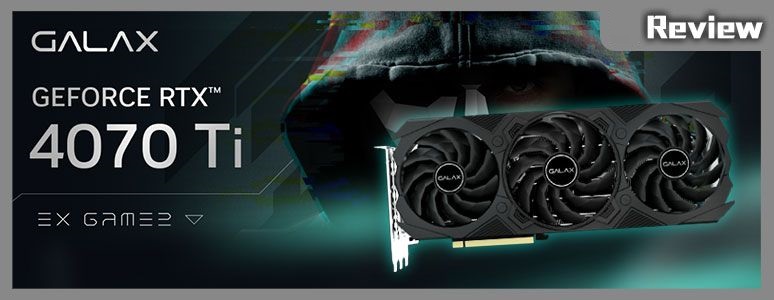
The GALAX GeForce RTX 4070 Ti EX Gamer with One-Click Overclocking features a subdued design but packs a performance punch. Equipped with a triple-fan setup and seven heat pipes, it offers more than adequate cooling capabilities. Under the hood, you’ll find an NVIDIA Ada Lovelace architecture RTX 4070 Ti GPU and 12GB of 192-bit GDDR6X memory. It also incorporates NVIDIA’s DLSS 3 technology, making 4K gaming at 60 fps a breeze.
Specs for the GALAX GeForce RTX 4070 Ti EX Gamer One-Click OC Graphics Card:
- Graphics Processor: NVIDIA GeForce RTX 4070 Ti
- PCI Express: 4.0 x16 interface
- CUDA Cores: 7680
- Tensor Cores: 240
- RT Cores: 60
- GPU Clock Speeds: One-Click OC at 2685 MHz, Boost at 2670 MHz, and Base at 2310 MHz
- Memory: 12GB GDDR6X
- Memory Clock Speed: 21 Gbps
- Memory Bandwidth: 192-bit
- Dimensions: 336 x 146 x 62 mm including bezel; 323 x 131 x 60 mm without bezel
- Slot Requirement: Takes up 3 slots
- Power Connector: Single 12VHPWR 16-Pin
- Recommended PSU: 700W or higher
- DirectX Support: DirectX 12 Ultimate
- OpenGL Support: Version 4.6
- Video Outputs: One HDMI 2.1 and three DisplayPort 1.4a
- Multi-Display Capability: Up to 4 screens
GALAX GeForce RTX 4070 Ti EX Gamer 1-Click OC graphics card out of the box
The RTX 4070 Ti EX Gamer 1-Click OC, introduced by GALAX Technology, leverages NVIDIA’s Ada Lovelace architecture, featuring 7680 CUDA cores and 12GB of GDDR6X video memory. The card also incorporates the RTX 40 series-exclusive NVIDIA DLSS 3 AI upscaling technology, delivering a significant boost in gaming performance.
This card is a first-of-its-kind for GALAX in the NVIDIA GeForce RTX 40 series lineup. Gamers can easily overclock the GPU to 2685 MHz using the 1-Click OC feature within GALAX’s “Xtreme Tuner Plus” software, eliminating the need for tedious manual adjustments.
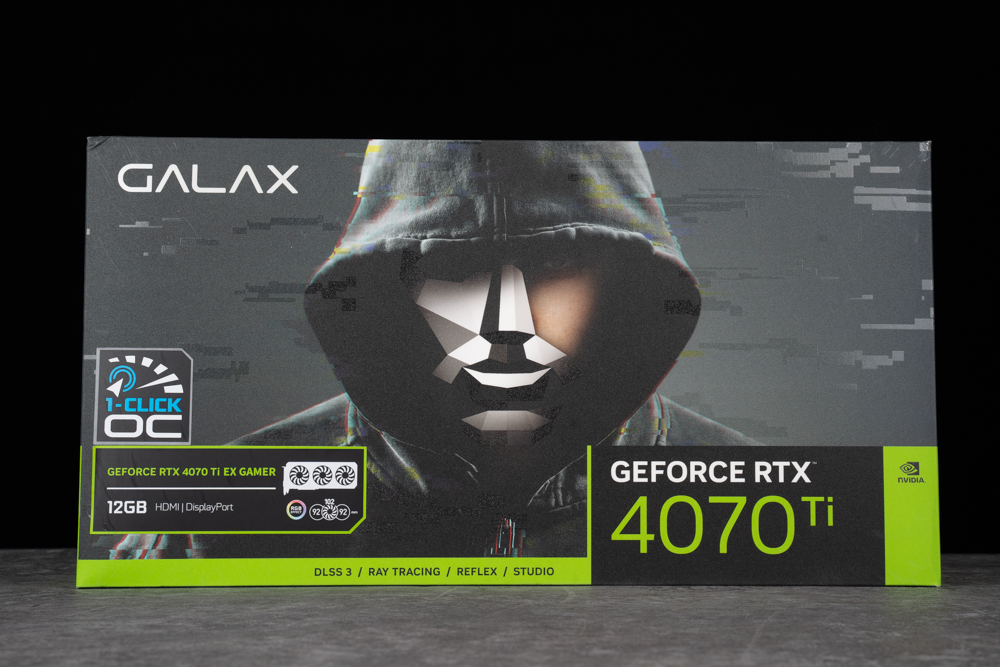
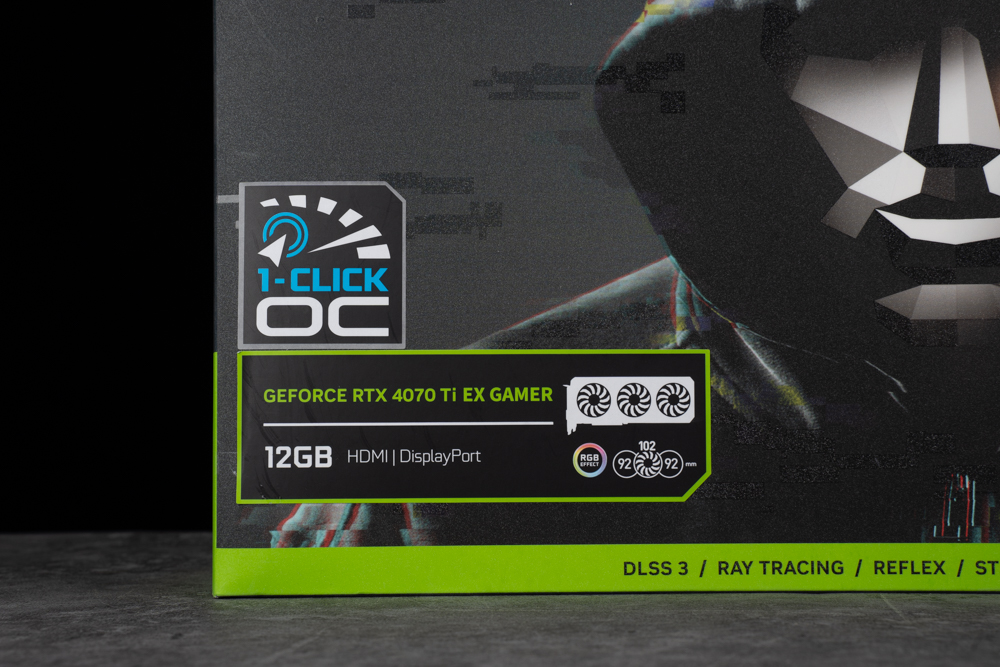
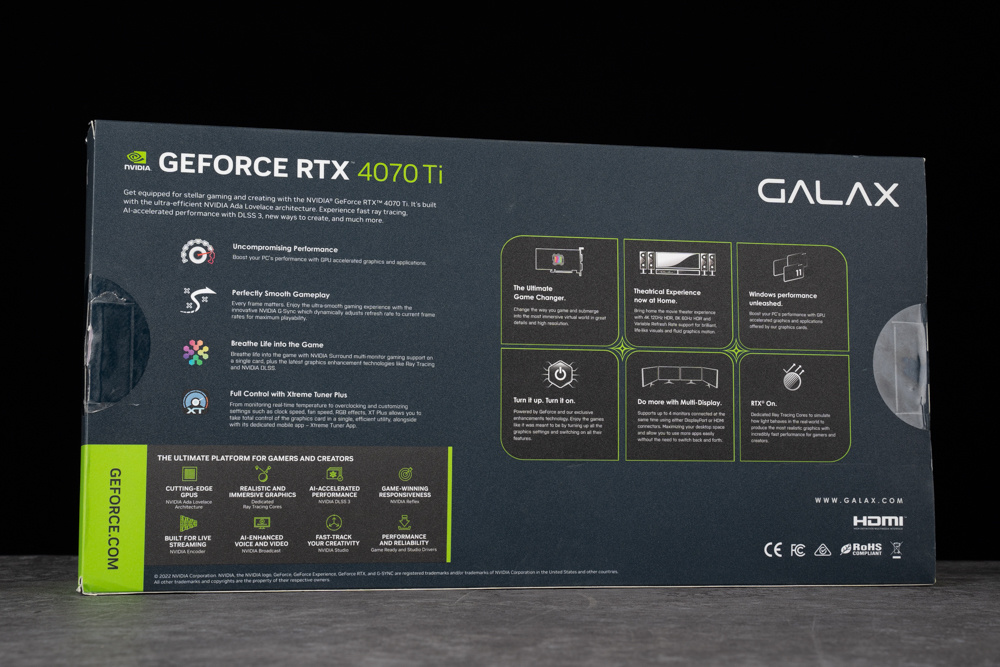
In addition to the standard black model, the RTX 4070 Ti EX Gamer 1-Click OC also comes in two other variants: Gamer White 1-Click OC and Gamer Pink 1-Click OC. These offer aesthetic choices for your setup. The re-engineered WINGS 2.0 cooling system features a triple-fan configuration, including two 92mm fans on each side and a 102mm fan in the center. This setup results in a 25% increase in air volume and a 15% boost in air pressure for enhanced heat dissipation.
The graphics card measures 336 x 146 x 62 mm. Due to its triple-fan design, it’s not particularly compact, so be sure to check if your case has enough space to accommodate it. The card’s design is understated, primarily featuring X-shaped, mechanical-style embossed patterns. For those looking for more elaborate lighting, the RTX 4070 Ti EX Gamer 1-Click OC V2 variant features semi-transparent fans that emit more extensive RGB lighting effects compared to the original version.
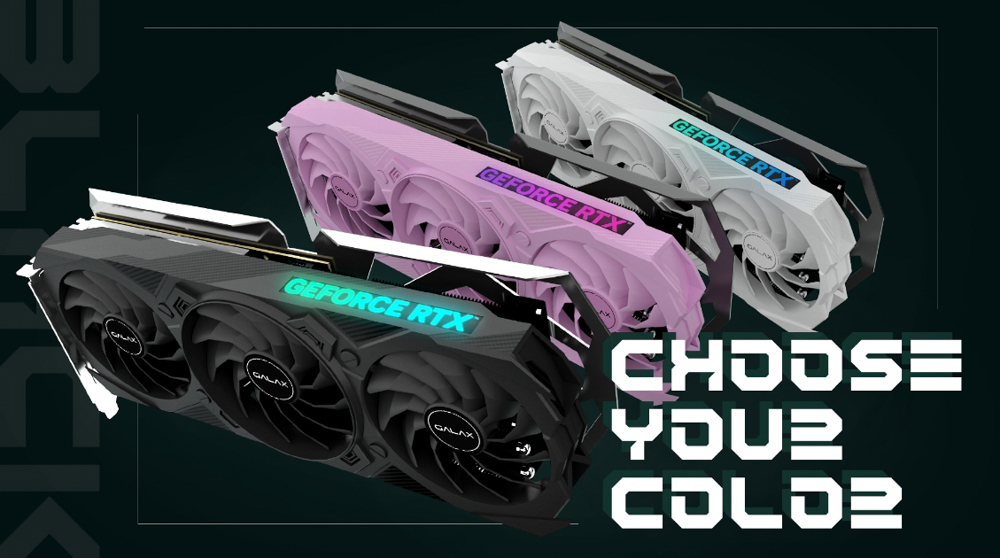
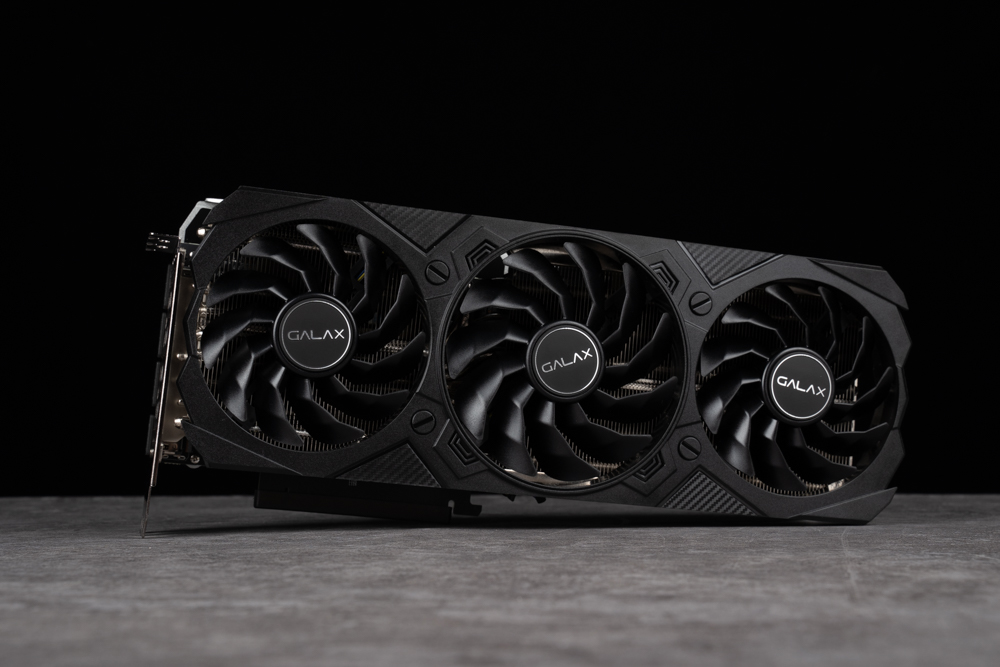
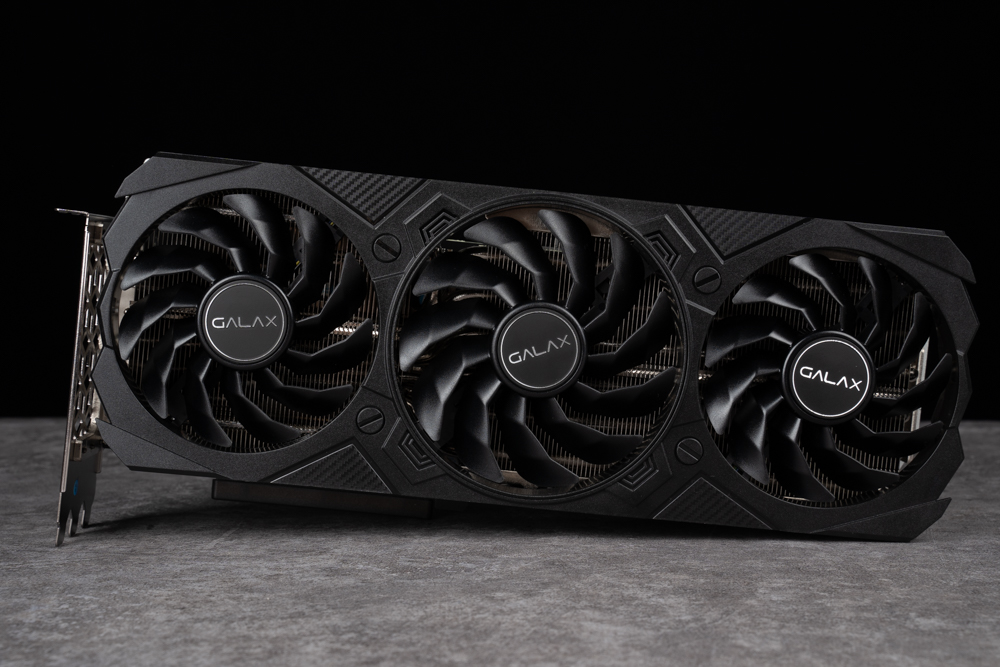
The overall thickness of the graphics card, including its bezel, stands at 6.2 cm. The cooling module itself takes up approximately 2.9 slots in the PCIe mounting area. For power, the card utilizes a 12+4 Pin 12VHPWR connector, and the manufacturer recommends a power supply unit (PSU) with a capacity of at least 700 watts. If you’re on a tight budget, you have options to make it work: either upgrade to a PSU that natively supports 12VHPWR cables or use the dual PCIe 8-Pin to 12VHPWR 16-Pin cables included in the package. This allows you to keep using your existing PSU, helping you save money while still adequately powering the card.
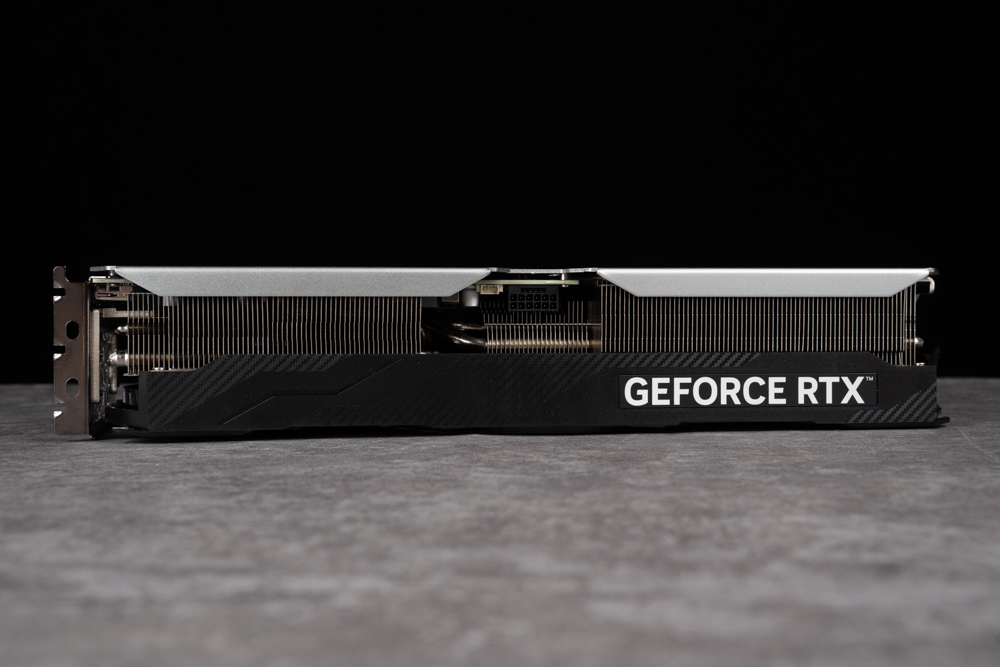
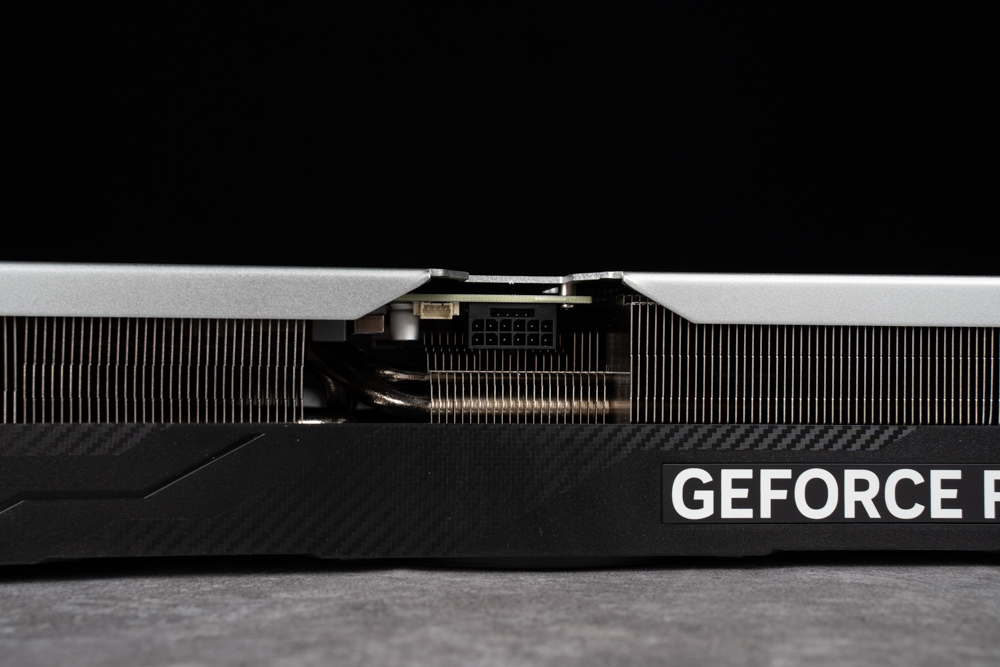
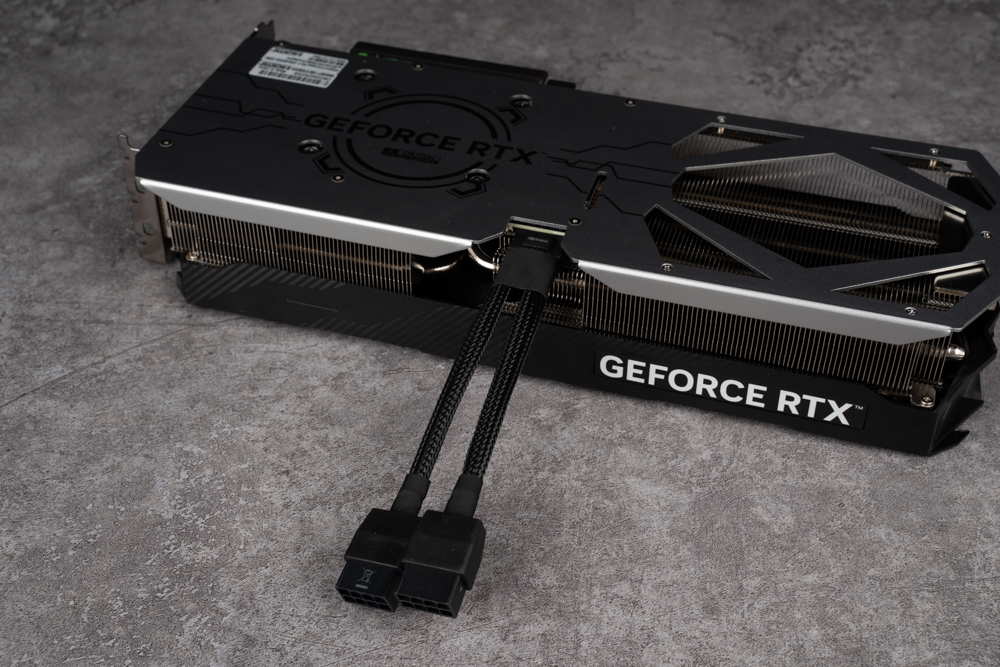
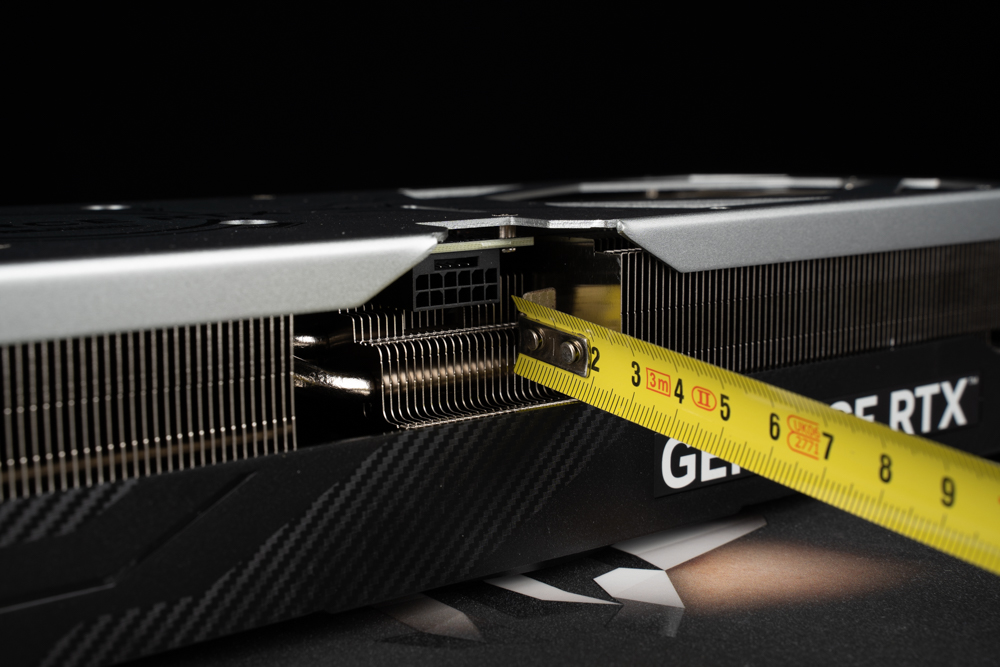
The rear side of the graphics card features a metal reinforcement plate to bolster the physical integrity of the PCB. This helps prevent warping over time due to the card’s weight. Besides the etched totem design on this metal backplate, there’s also an exhaust vent at the end near the fan. This design allows air to flow straight up after it moves through the cooling fins and heat pipes, aiding in effective heat dissipation.
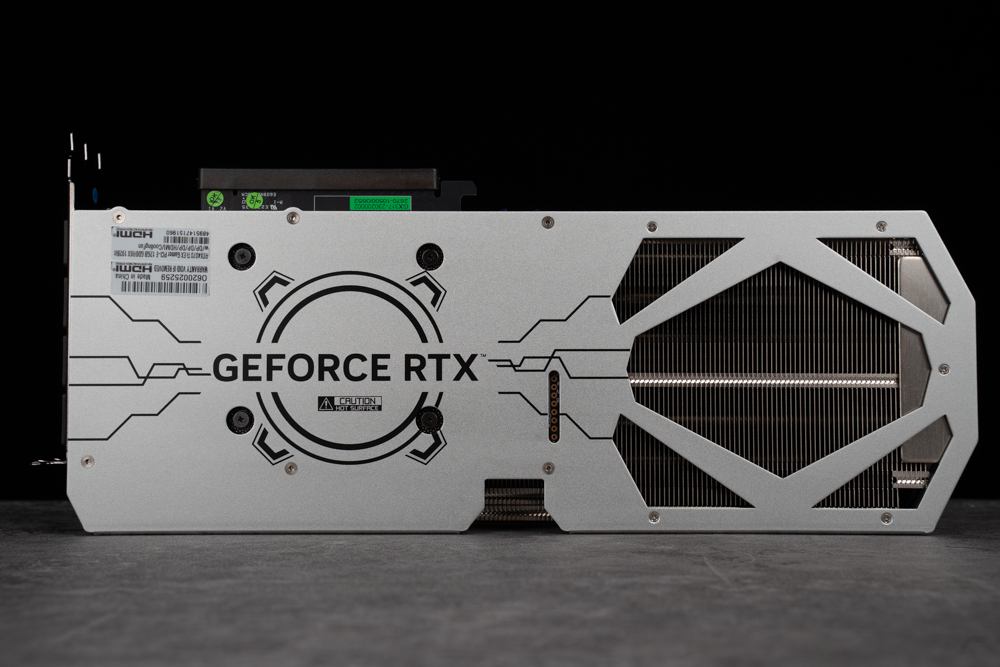
The graphics card offers a variety of display connections, including three DisplayPort 1.4a ports and a single HDMI 2.1 port. You can use up to four display connections simultaneously. Dust plugs are also provided to shield the ports from dust accumulation and oxidation.
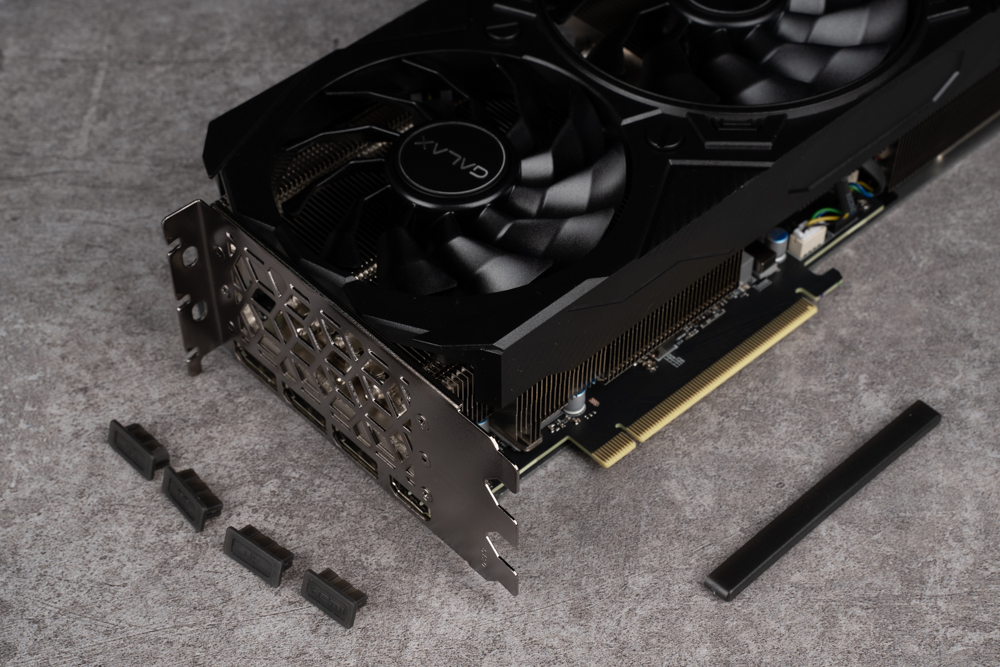
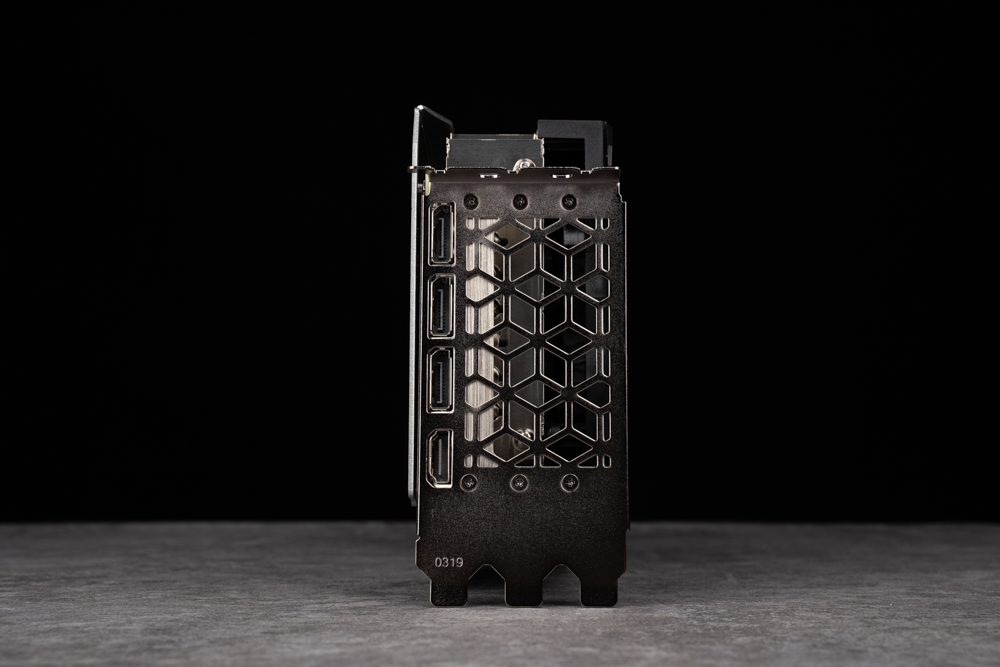
The graphics card package comes with extra accessories like a dual PCIe 8-Pin to 12VHPWR 16-Pin power cable, an ARGB cable for the graphics card, and a support bracket to help stabilize the card.

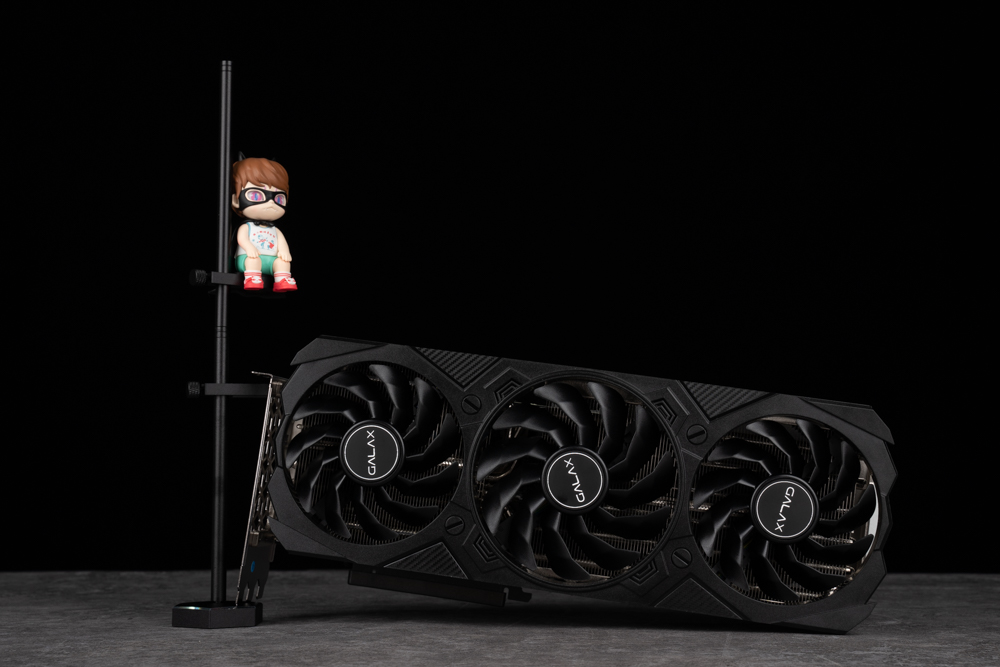
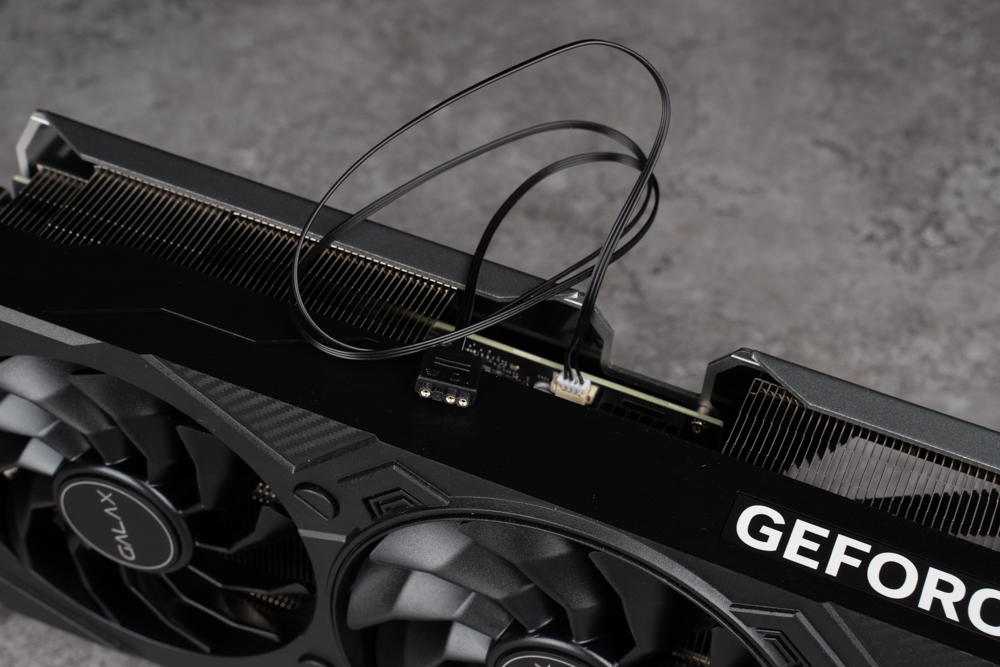
The only area featuring RGB lighting on the GALAX GeForce RTX 4070 Ti EX Gamer 1-Click OC graphics card is situated at the card’s edge near the end. You can personalize the lighting of the GeForce RTX emblem using the GALAX Xtreme Tuner Plus software.
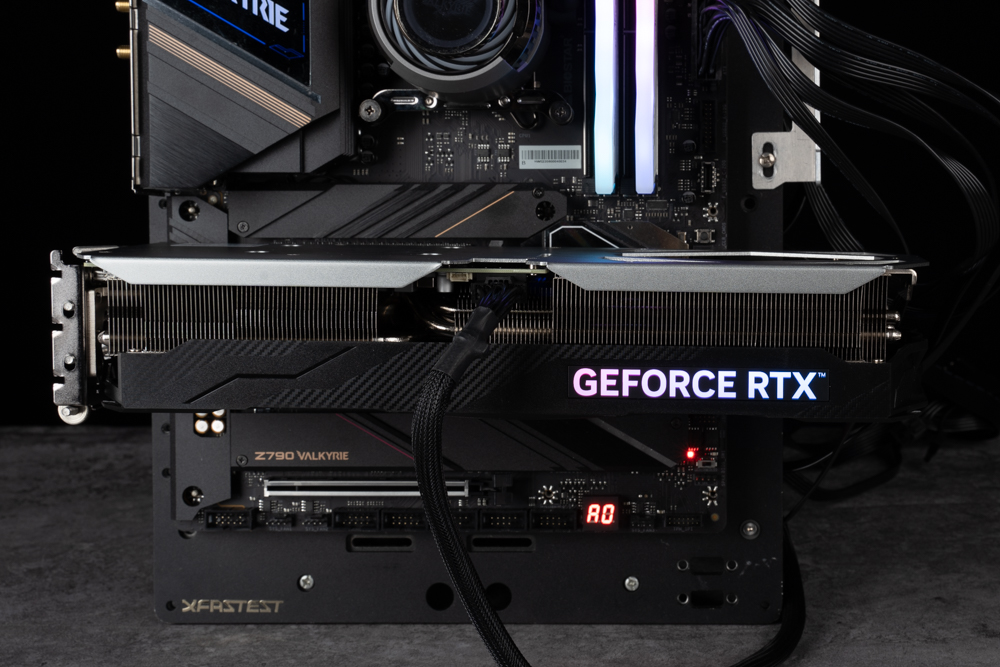
Upon disassembling the graphics card, it’s evident that the card features a compact PCB. It uses a cooling system made up of seven intricately bent heat pipes along with a vapor chamber to efficiently manage the core and memory temperatures. To get a clear look at the elaborate heat pipe arrangement, you’d have to fully remove the cooling module. The vapor chamber’s surface has a metal brushed finish and is coupled with numerous thermal pads, aiding in heat dissipation not just for the GPU core but also for the card’s power components.
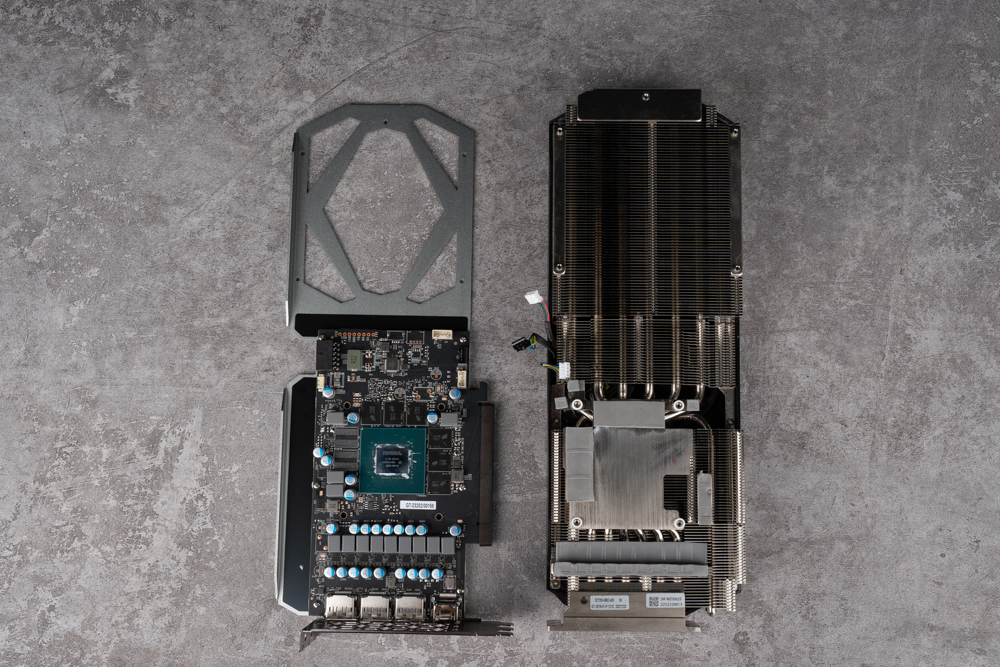
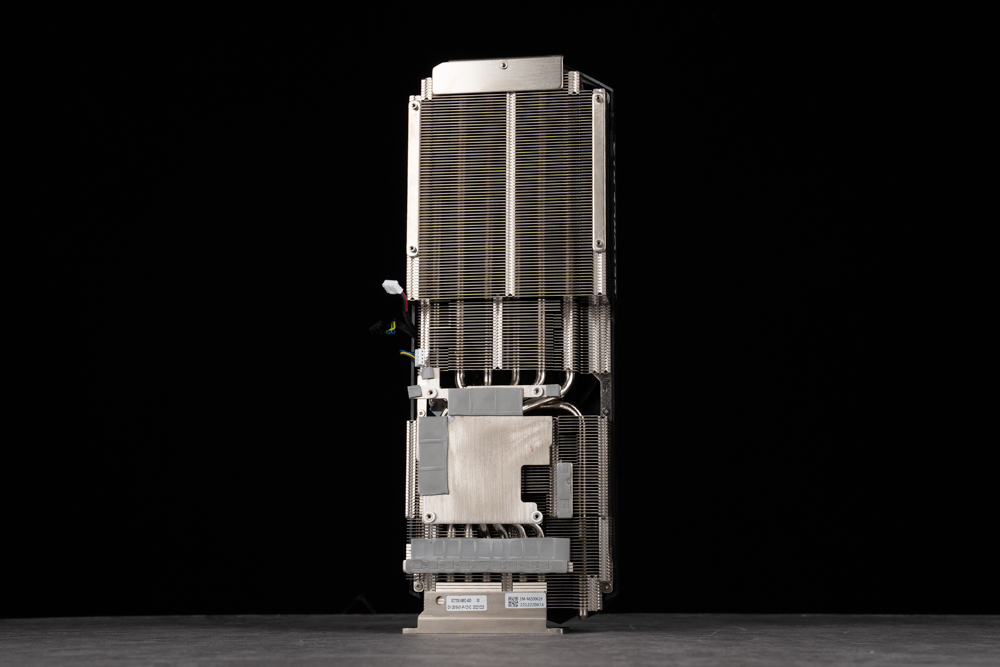
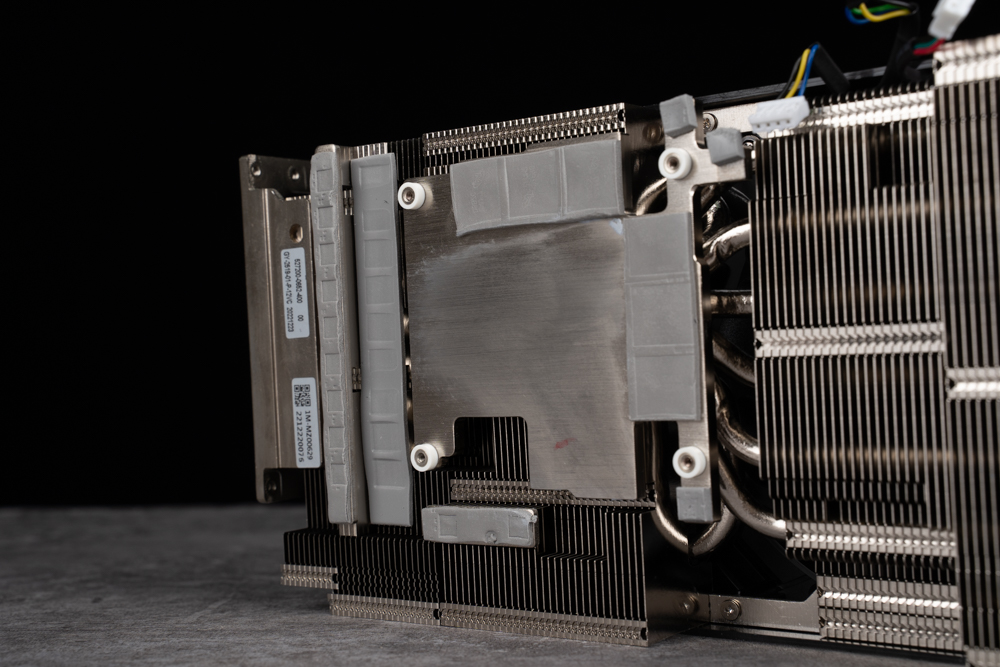
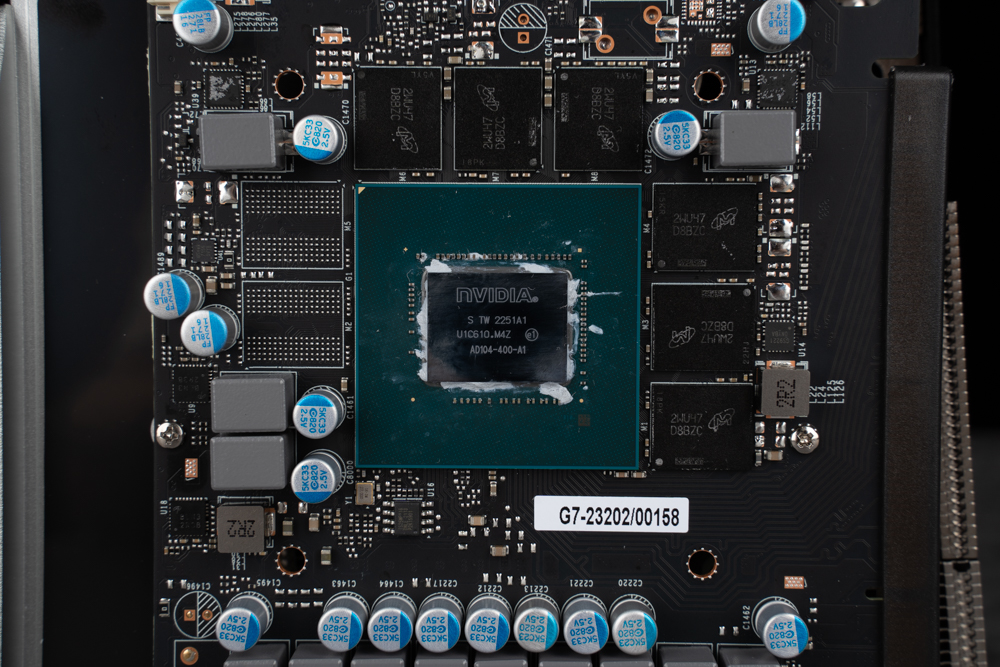
Graphics card control instrument GALAX Xtreme Tuner Plus software
With GALAX’s Xtreme Tuner Plus software, users have the ability to manually fine-tune their graphics card settings. This includes overclocking the GPU, adjusting RGB lighting, and customizing the fan speed curves.
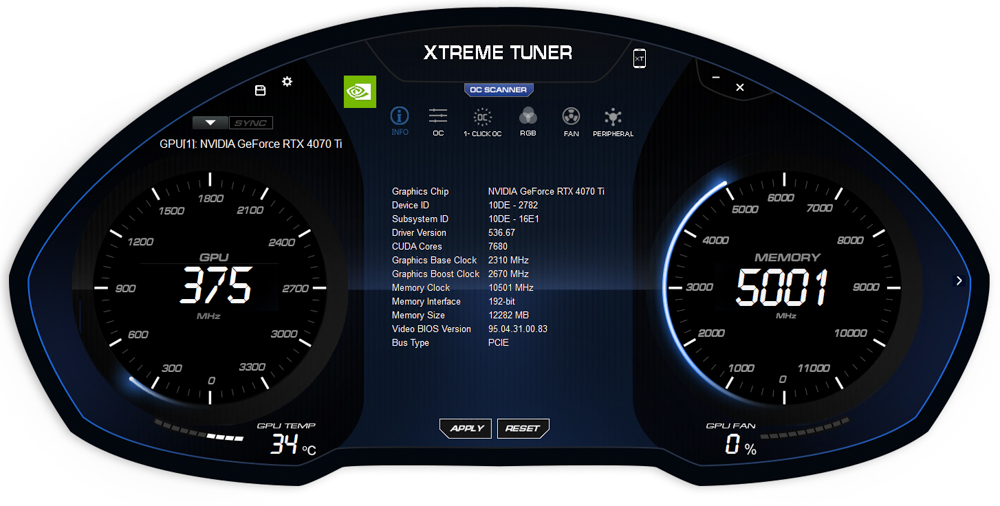
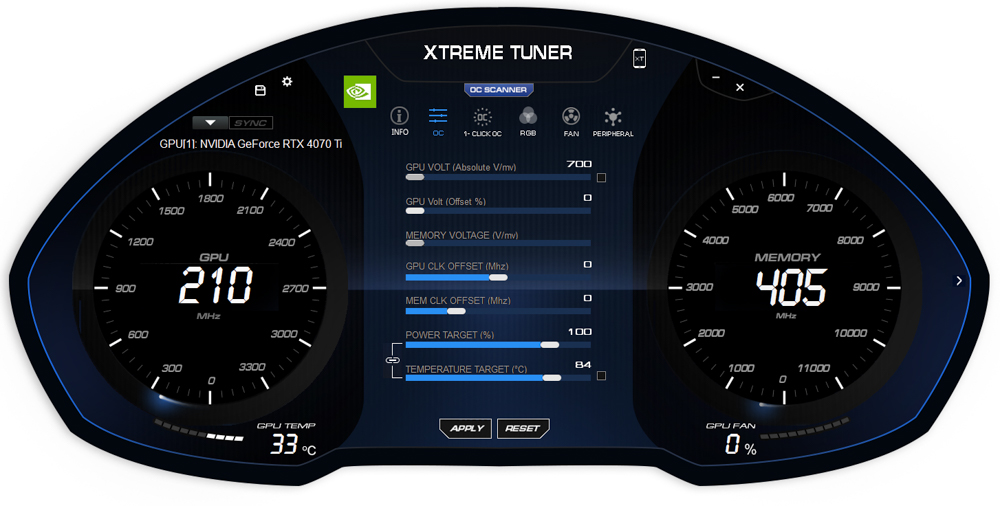
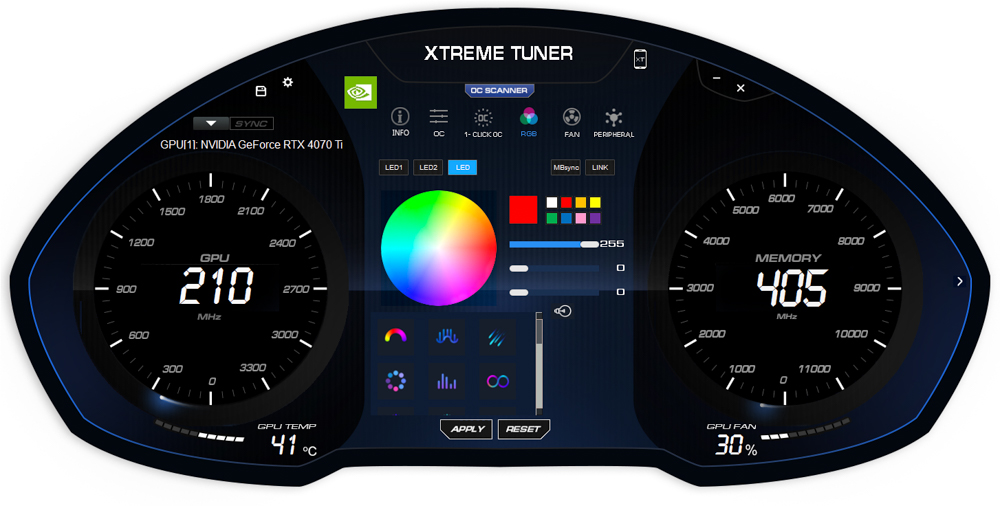
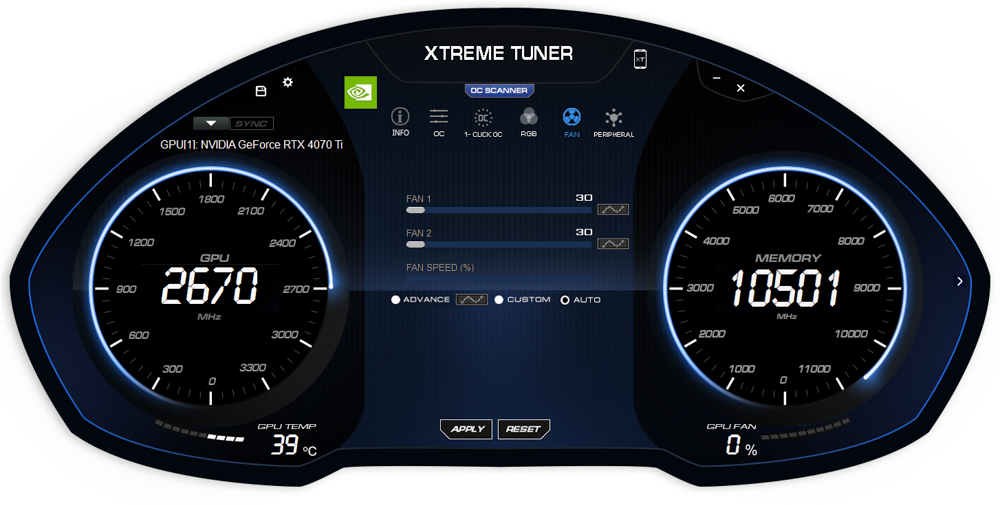
The GALAX GeForce RTX 4070 Ti EX Gamer 1-Click OC features a convenient 1-Click OC function that allows you to instantly overclock the GPU from its Boost frequency of 2670 MHz to 2685 MHz with just a single click.
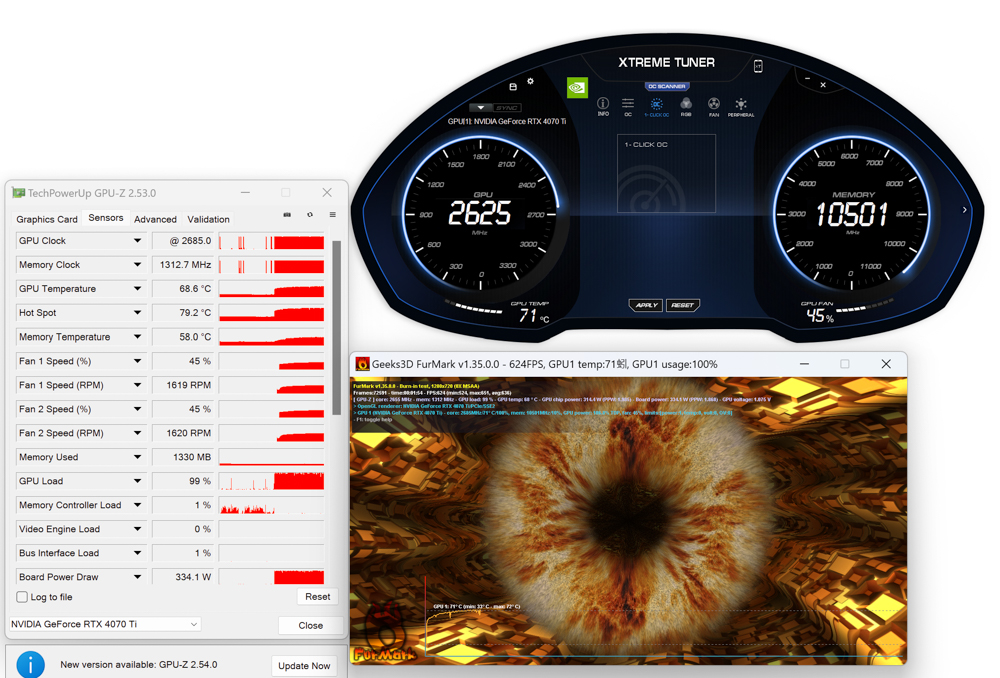
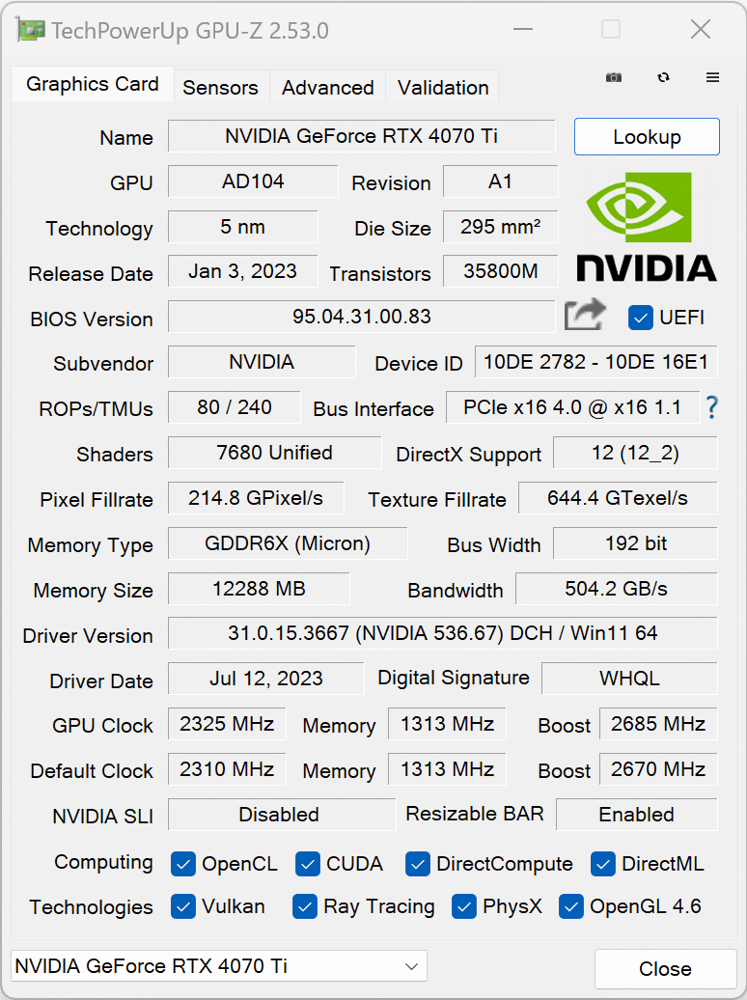
Display card professional creation and rendering test
A range of eight specialized benchmarking software applications were employed for comprehensive testing, including OctaneBench 2020.1.5, Indigo Bench, Blender Benchmark, SPECviewperf 2020 v3.1, Superposition 2017, UL Procyon benchmark, Vray5, and Geekbench 6. These tests covered various metrics, such as rendering and video conversion. The benchmarks were run on a system powered by an Intel Core i9 12900K CPU, BIOSTAR Z790 VALKYRIE motherboard, and T-Force DELTA RGB DDR5 6200 MT/s 16GBx2 dual-channel RAM. The star of the show, the GALAX GeForce RTX 4070 Ti EX Gamer 1-Click OC graphics card, was tested in this setup.
The motherboard’s BIOS, version Z79AC510, had both XMP 3.0 and Resizable Bar features enabled. The 1-Click OC functionality was also activated via the Xtreme Tuner Plus software, pushing the GPU clock to 2685 MHz. The graphics card driver used for testing was the GeForce Game Ready 536.67 version.
Test Setup Details:
- Processor: Intel Core i9 12900K
- Cooling System: VALKYRIE C360-RGB
- Motherboard: BIOSTAR Z790 VALKYRIE (BIOS version Z79AC510)
- Memory: T-Force DELTA RGB DDR5 6200 MT/s 16GBx2
- Graphics Card: GALAX GeForce RTX 4070 Ti EX Gamer 1-Click OC
- Operating System: Windows 11 Pro 21H2
- System Drive: Corsair MP600 PRO LPX 1TB PCIe Gen4 x4 NVMe M.2 SSD
- Game Storage: GIGABYTE AORUS NVMe Gen4 SSD 2TB
- Power Supply: FSP Hydro G PRO ATX3.0 (PCIe5.0) 850W
- Graphics Driver: GeForce Game Ready 536.67
Upon checking the GPU-Z information, the GALAX GeForce RTX 4070 Ti EX Gamer 1-Click OC graphics card features 7680 CUDA cores on its 5nm AD104 core. The card comes with 192-bit 12GB GDDR6X memory from Micron, and its default clock rates are 2310 MHz for the GPU and a boost clock of 2670 MHz.
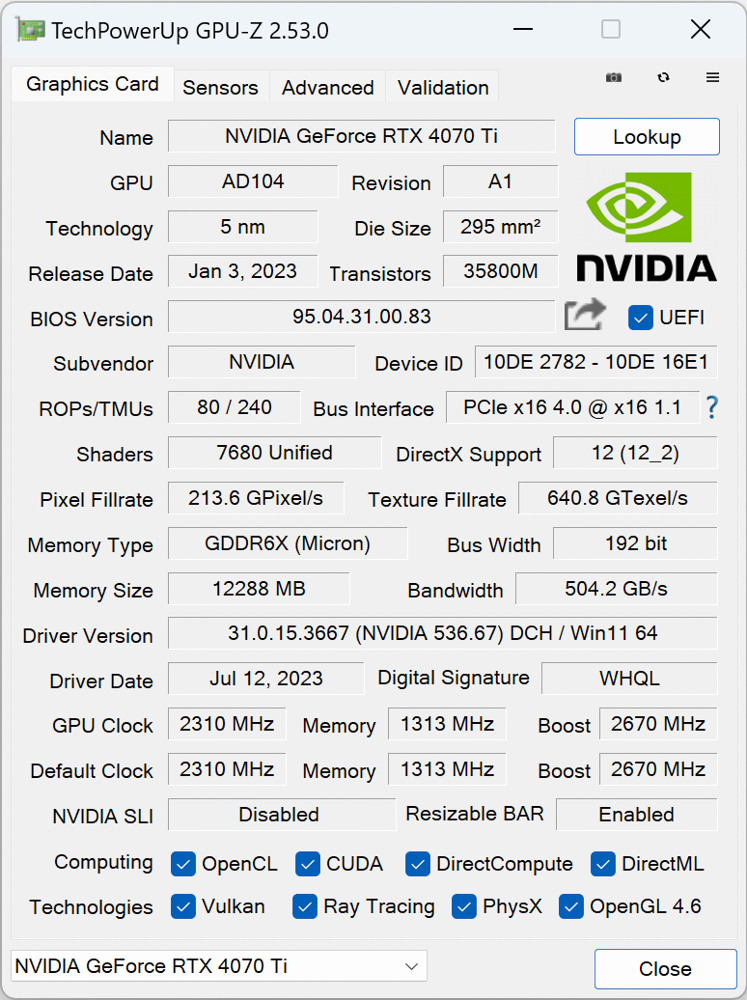
OctaneBench 2020.1.5 is a specialized benchmarking tool based on the OctaneRender GPU rendering engine. This free tool allows users to assess the rendering capabilities of their graphics cards. Starting with version 2020.1.1, OctaneRender has incorporated ray tracing effects, enabling NVIDIA’s RTX series cards to activate RTX acceleration within the OctaneBench 2020.1 framework. When evaluated for its ray tracing rendering performance, the card achieved a score of 739.51 points.
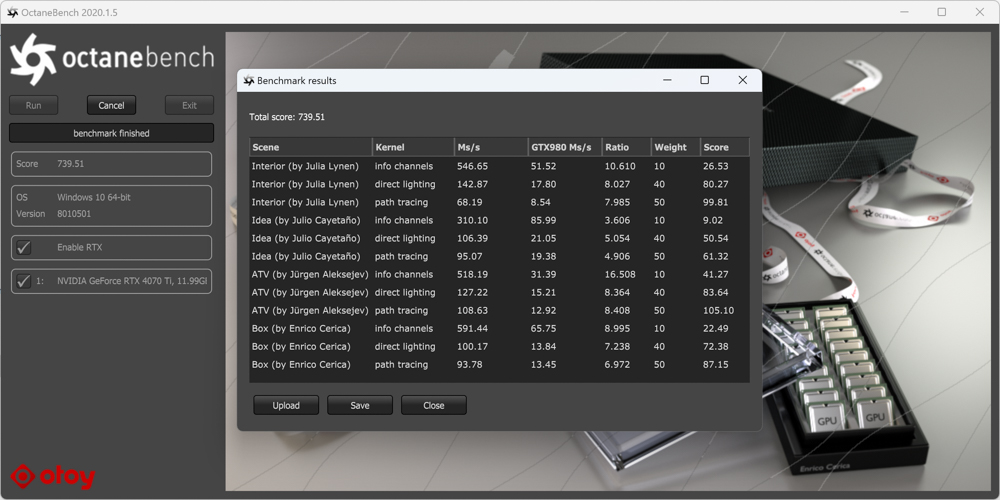
Indigo Bench is a complimentary benchmarking application that utilizes the Indigo 4 rendering engine. It’s compatible with a wide range of hardware, supporting NVIDIA, AMD, and Intel graphics cards and processors through its OpenCL architecture. During the benchmarking process, it offers two sample scenes—a bedroom and a sports car—for rendering performance evaluation. The metric for assessing rendering completion is measured in grades, where a higher grade indicates better performance. In this particular test, the bedroom scene received a score of 20.091 M samples/s, while the sports car scene achieved a score of 52.846 M samples/s.

Blender Benchmark Launcher 3.6.0 is a no-cost benchmarking tool offered by the 3D graphics application Blender. During the benchmarking phase, users have the option to evaluate either CPU or GPU performance. The tool carries out the tests across three different scenes: Monster, Junkshop, and Classroom.
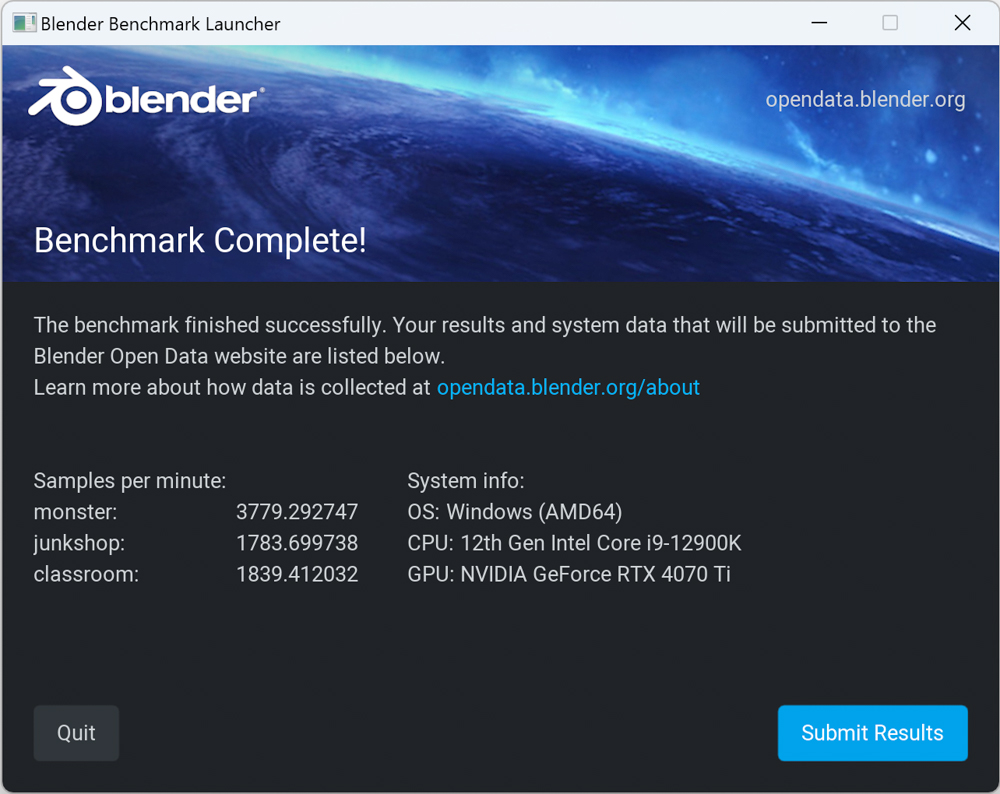
SPECviewperf 2020 v3.1 encompasses 3D graphics and rendering benchmarks tailored for diverse professional industries. The software employs both OpenGL and DirectX APIs to simulate 3D graphical performance. For this round of testing, a variety of tasks were executed at a 4K resolution of 3840×2160. The tests included simulations for software like 3ds Max, CATIA, Creo, Energy, Maya, as well as specialized applications for medical, snx, and SolidWorks benchmarks.
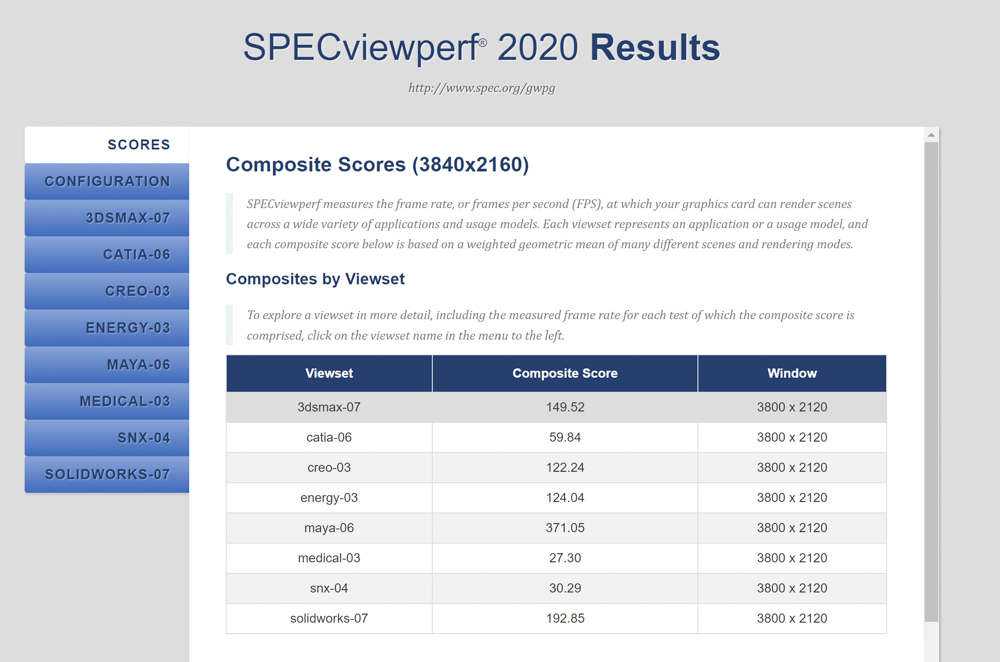
Superposition 2017 is a benchmarking utility built on the UNIGINE 2 engine, which is commonly used in simulator development, cross-platform gaming, VR experiences, and 3D design software. The tool supports various Graphics APIs, including OpenGL 4, Vulkan, and DirectX 12. During benchmarking, users have the option to test different Graphics APIs by selecting DirectX and choosing between 4K and 8K image quality for accurate performance measurement. In this case, the software recorded an average FPS of 124.59 for the 4K test, and 46.73 FPS for the 8K evaluation.
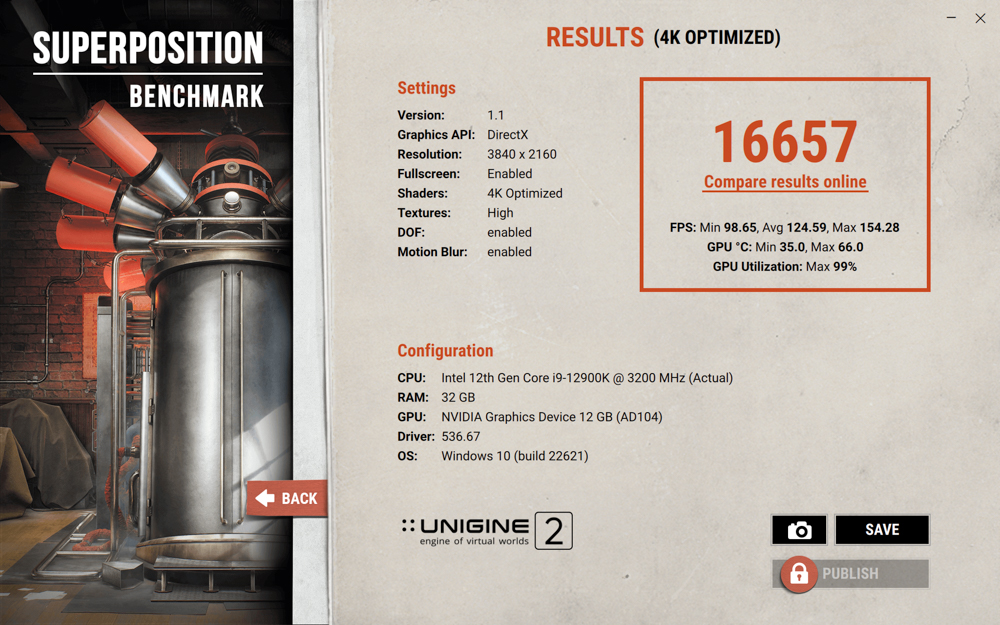
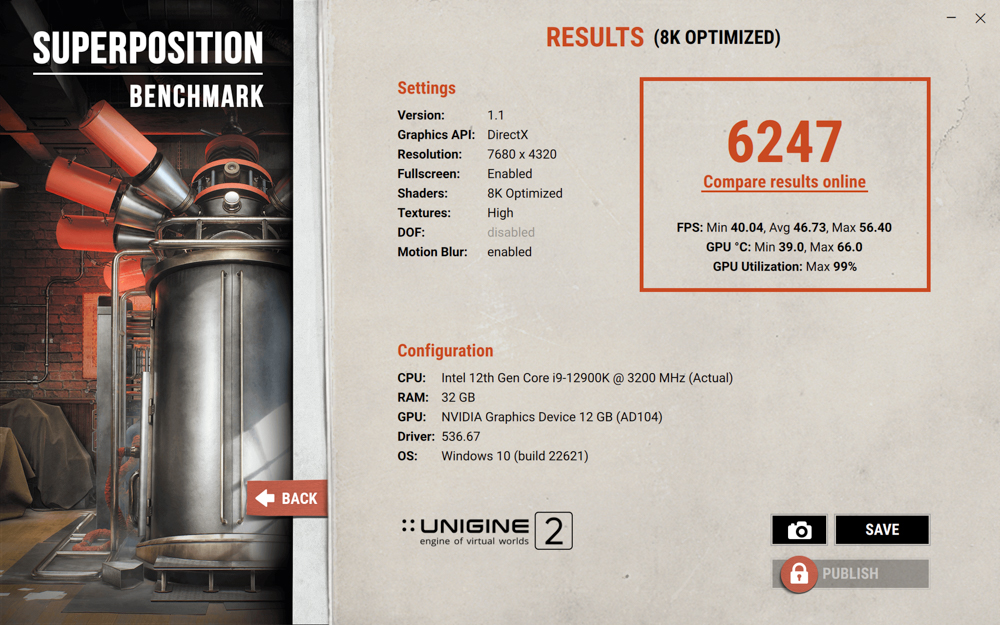
UL Procyon utilizes a pair of benchmarks aimed at evaluating video and photo editing performance, both of which rely on Adobe’s suite of software for the tests.
In the Video Editing Benchmark, Adobe Premiere Pro is employed for the evaluation. Given that there has never been a standard test reference for Premiere Pro among media editing professionals, this particular test imports two video clips for editing and adjustment. Once the special effects have been configured, the software proceeds to export the videos in both H.264 (YouTube 1080P) and H.265 (4K) formats to obtain a cumulative score.
As for the Photo Editing Benchmark, the first phase imports a digital negative (DNG) file into Adobe Lightroom Classic. The test involves cropping, adjusting, and modifying the DNG image. The second phase uses Adobe Photoshop to apply a range of layer editing effects to multiple images. These images are then exported, resulting in scores for image retouching and batch processing.
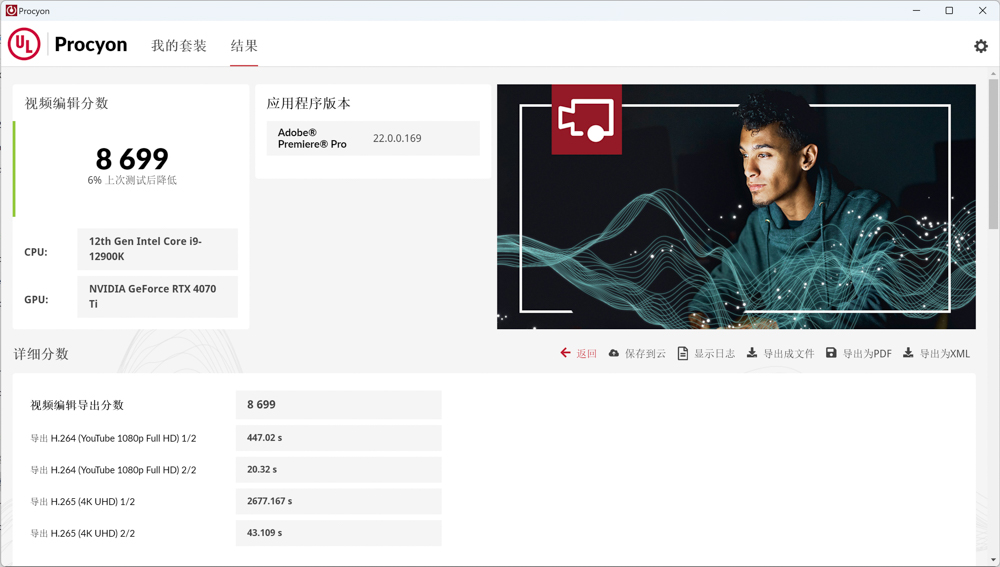
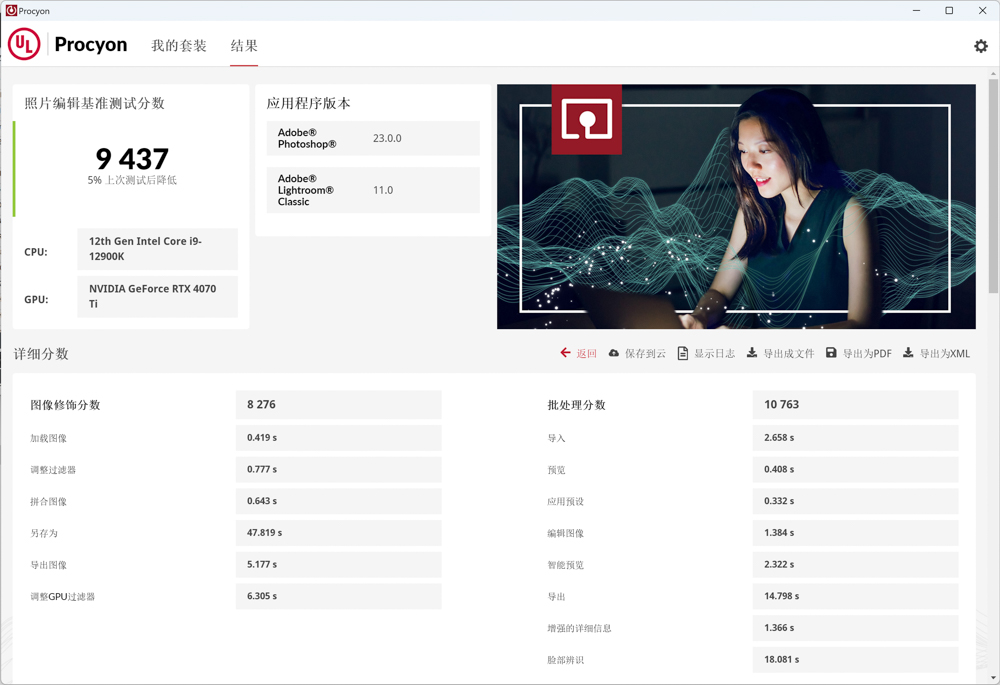
V-Ray 5 is a benchmarking tool designed by Chaos Group to evaluate the performance of the V-Ray rendering engine on both CPUs and GPUs. The software offers the option to test either component individually or in tandem via its CUDA projects, which allow for the simultaneous rendering of CPU and GPU. Additionally, the software is compatible with NVIDIA’s RTX series of graphics cards, enabling specific tests focused on ray tracing rendering performance.
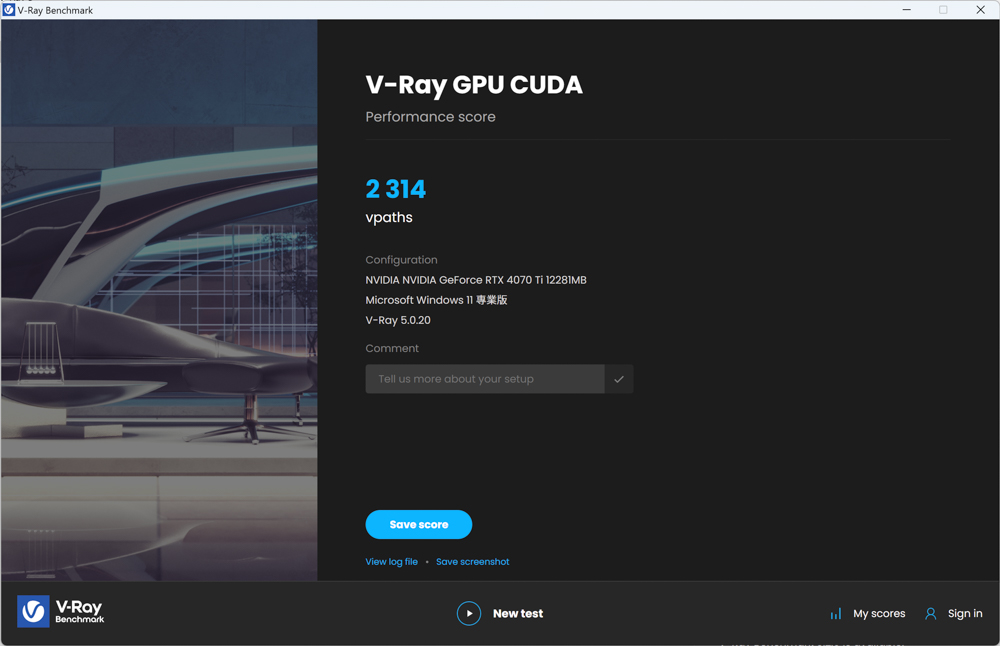
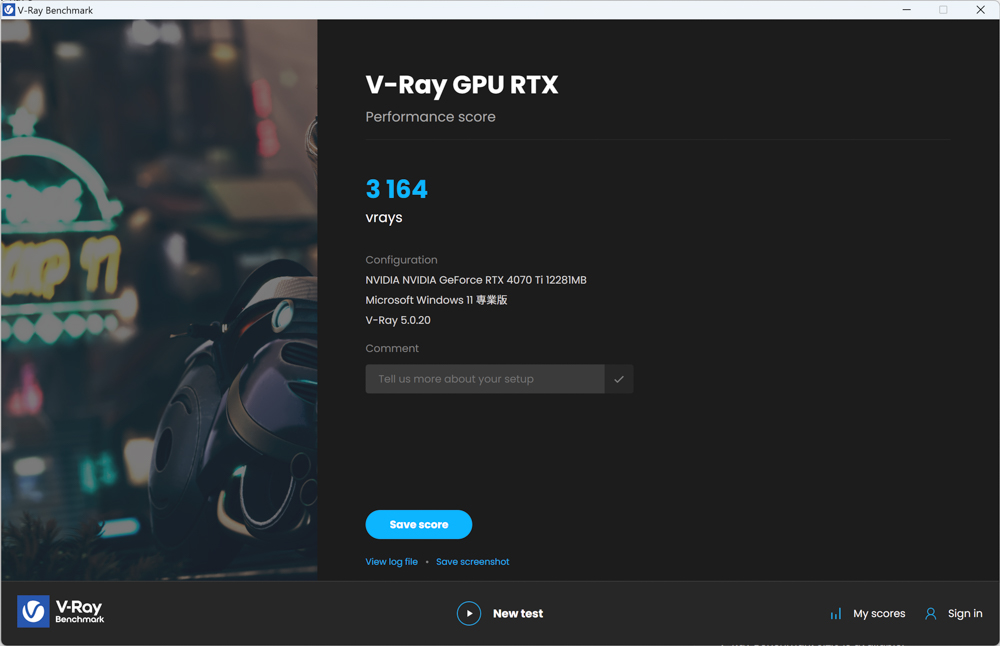
Geekbench 6 is a comprehensive benchmarking tool that includes tests for both CPU and GPU performance. In its GPU Compute Benchmark project, Geekbench 6 assesses the graphics card’s capabilities across a wide range of professional workloads such as image processing, rendering, and machine learning (ML). The test covers an extensive list of tasks, including but not limited to:
- Deep learning workloads
- Background blur
- Face detection
- Image editing
- Level detection
- Edge detection
- Gaussian blur
- Image synthesis
- Feature matching
- Stereo matching
- Particle physics
Users have the flexibility to choose between different GPU APIs like OpenCL or Vulkan for conducting these tests, allowing for a more comprehensive evaluation of the graphics card’s performance. Overall, Geekbench 6 aims to give a total score that reflects the GPU’s capability in professional scenarios.
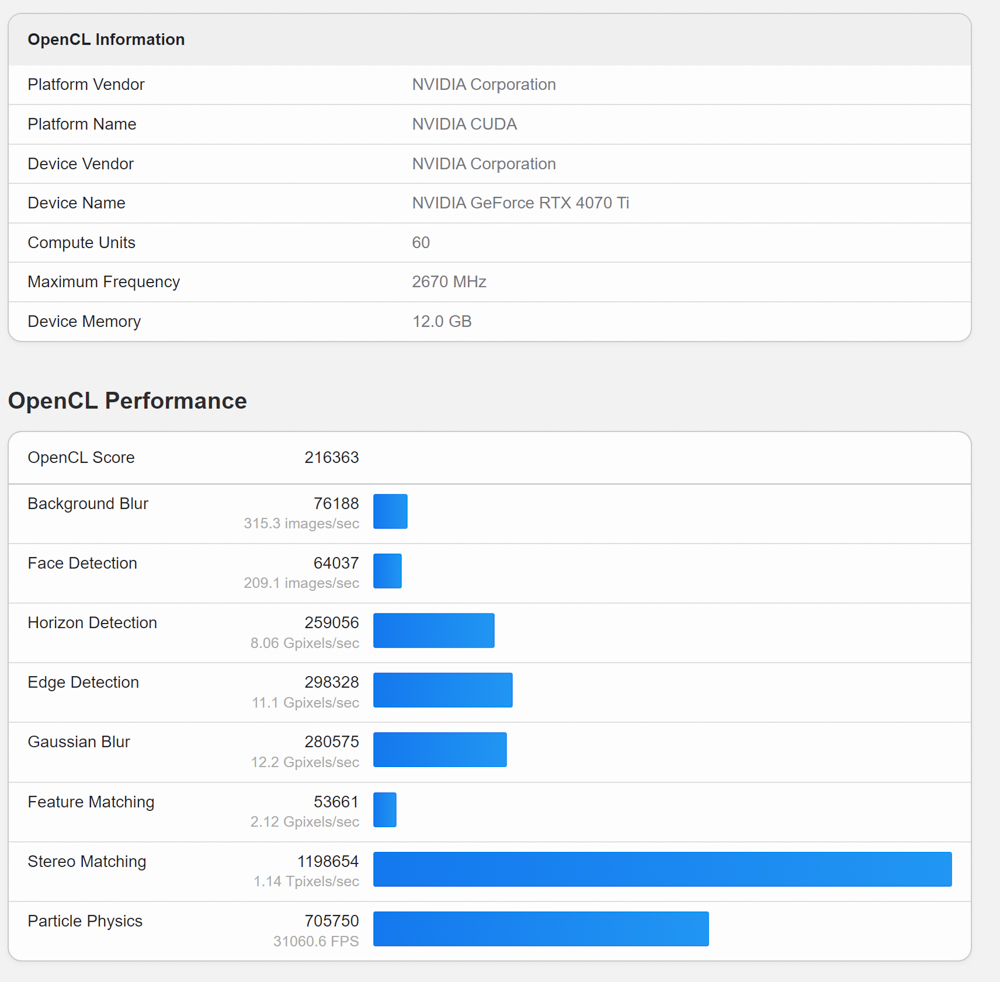
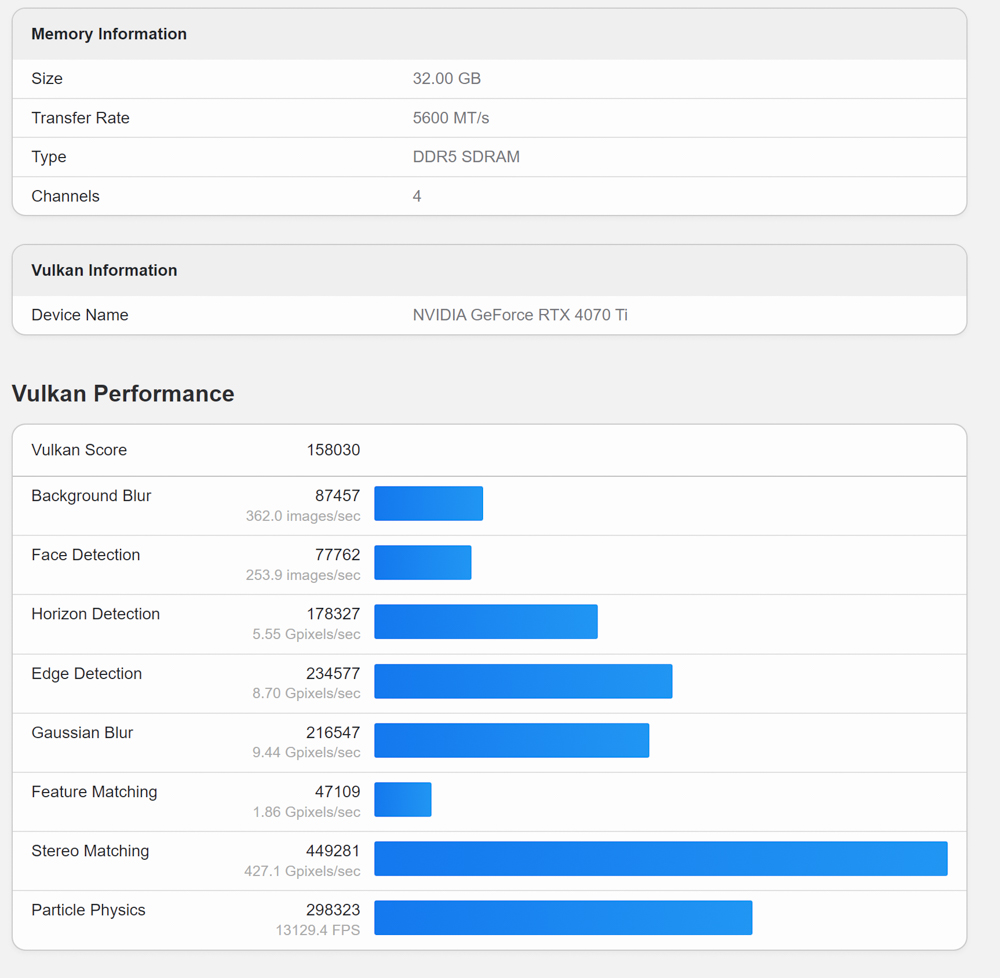
3DMark running score test
Summarizes the results obtained from 3DMark testing for the GALAX GeForce RTX 4070 Ti EX Gamer 1-Click OC graphics card.
Test Setup:
- Driver: GeForce Game Ready 536.36
- Software: 3DMark
- Settings: XMP and Resizable Bar enabled, 1-Click OC function enabled through Xtreme Tuner Plus
3DMark Fire Strike Test Results:
Fire Strike is a DirectX 11 benchmark test in 3DMark designed to gauge the gaming capabilities of a system, with various sub-tests including physics, CPU, and GPU performance across different resolutions.
Fire Strike 1080p:
- Total Score: 41087
- Graphics Score: 53293
Fire Strike Extreme 1440p:
- Total Score: 25700
- Graphics Score: 26537
Fire Strike Ultra 2160p (4K):
- Total Score: 13498
- Graphics Score: 13202
These scores offer a comprehensive view of the card’s performance across different resolutions, suggesting that the GALAX GeForce RTX 4070 Ti EX Gamer 1-Click OC is capable of delivering impressive gaming performance at various levels of image quality.
The results are particularly useful for gamers and enthusiasts looking to understand how well this graphics card can handle demanding game titles at different resolutions.
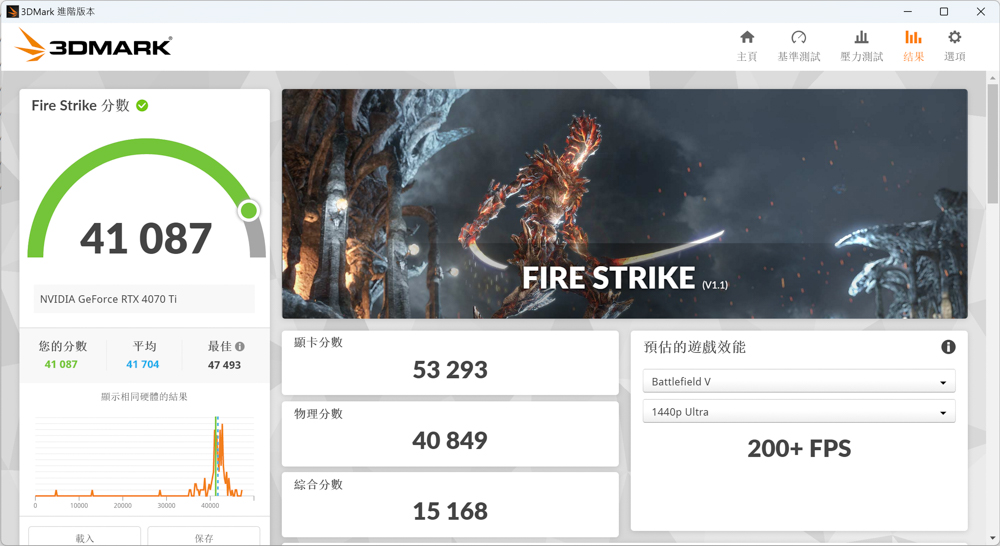
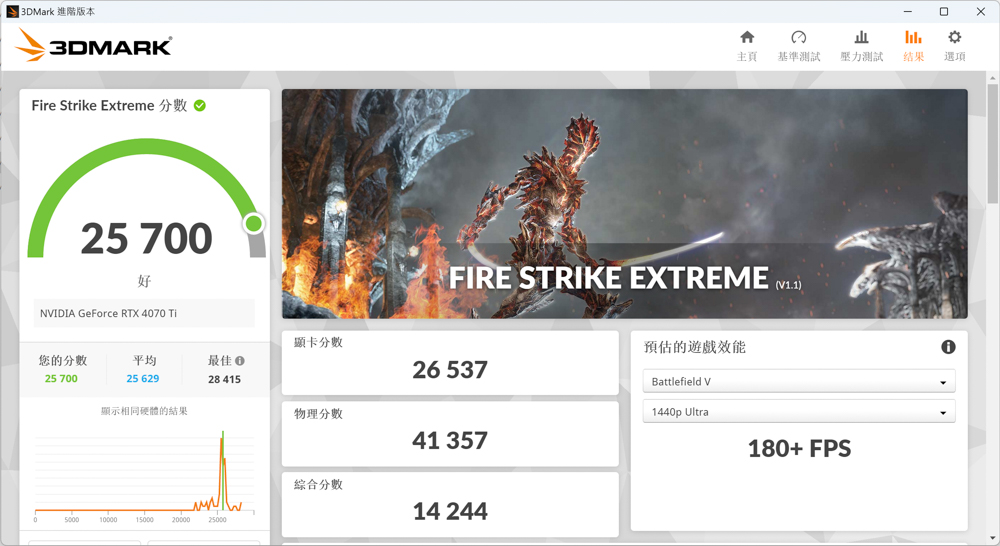
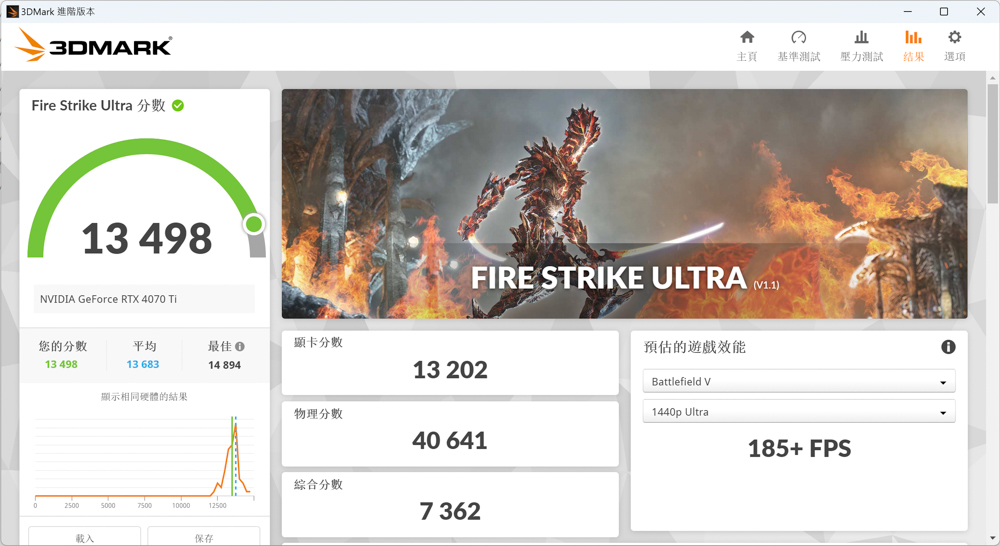
3DMark Time Spy Test Results:
3DMark Time Spy is another crucial test in the 3DMark suite, geared towards measuring DirectX 12 performance. This test is more future-proof, as it’s designed to handle the increased demands of newer gaming titles.
Time Spy 1440p (2K):
- Total Score: 22060
- Graphics Score: 22576
Time Spy Extreme 2160p (4K):
- Total Score: 10558
- Graphics Score: 10882
These Time Spy results further establish the GALAX GeForce RTX 4070 Ti EX Gamer 1-Click OC as a high-performing graphics card capable of handling modern gaming titles at both 2K and 4K resolutions.
The Time Spy score is an excellent indicator of how well the graphics card will perform with DirectX 12 games, which are becoming increasingly common. The Time Spy Extreme score suggests that the card also has good 4K gaming capabilities, which will be vital for users looking to play games at Ultra HD resolutions.
Overall, these scores corroborate the previous Fire Strike results, indicating that this GALAX card is a strong performer across various gaming scenarios and resolutions.
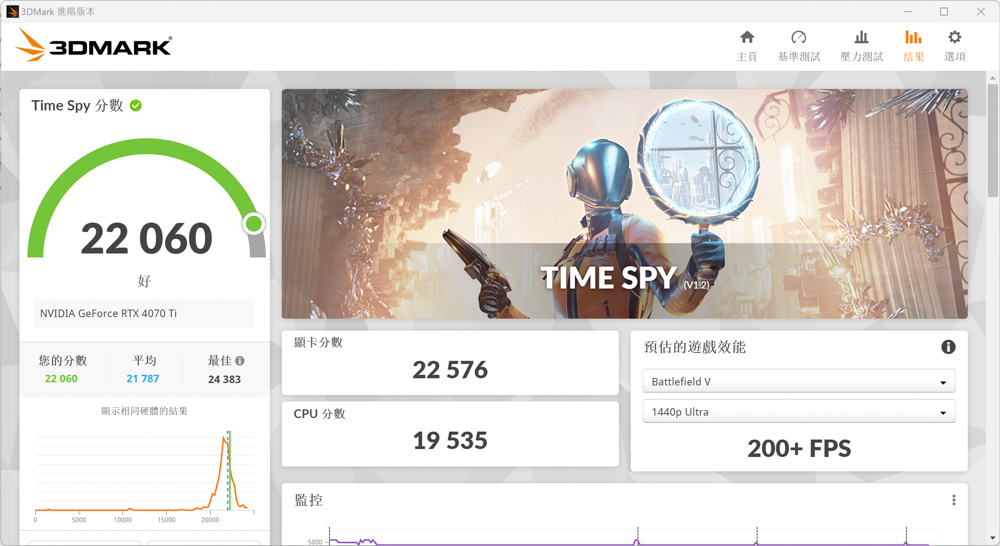

3DMark Port Royal Test Results:
Port Royal is a relatively newer addition to the 3DMark benchmark suite and specifically targets performance with DirectX Raytracing (DXR). This test not only measures rasterization performance but also adds a layer of complexity with real-time ray tracing. It’s an excellent metric for assessing how well a GPU will handle upcoming titles that make use of ray tracing for more realistic lighting, reflections, and shadows.
- Port Royal 1440p (2K):
- Total Score: 13919
The score of 13919 is highly indicative of strong ray-tracing capabilities. Considering the demanding nature of real-time ray tracing, a score in this range suggests that the GALAX GeForce RTX 4070 Ti EX Gamer 1-Click OC is well-equipped to handle ray tracing in modern games at a 2K resolution. The inclusion of DLSS (Deep Learning Super Sampling) also means that gamers can potentially get even better performance with minimal loss in visual quality.
This result complements the previously mentioned Time Spy and Fire Strike scores, further solidifying the graphics card as a versatile, high-performing piece of hardware that is capable of running the most demanding of modern game titles.
It’s worth mentioning that ray tracing is one of the most hardware-intensive technologies to date, and the Port Royal score shows that this graphics card is up to the task. For gamers interested in experiencing the pinnacle of visual fidelity, this card should deliver on those expectations.
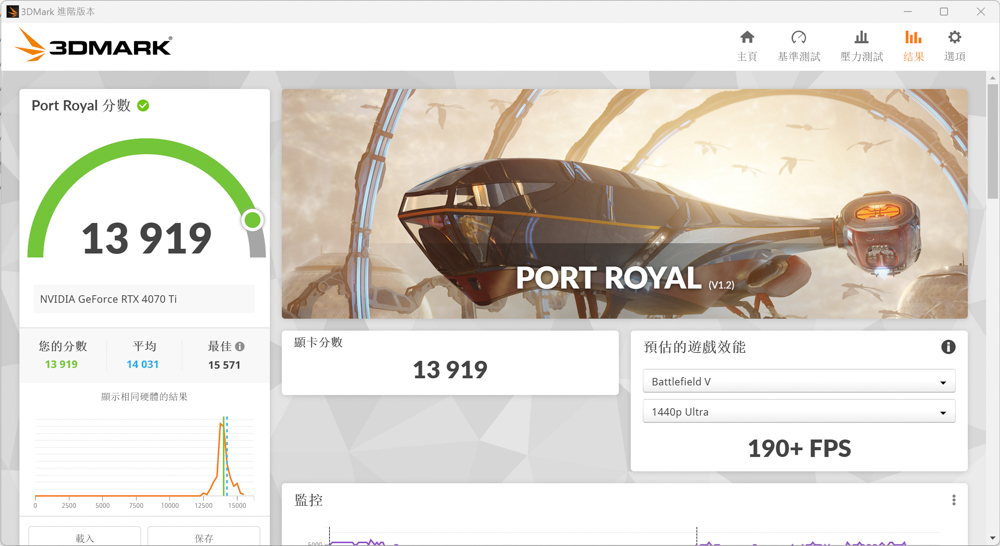
Speed Way Benchmark Test Results:
Speed Way is a more recent benchmark utilizing the latest DirectX 12 Ultimate API features, including enhanced ray tracing capabilities (DirectX Raytracing tier 1.1), global lighting, ray-traced reflections, and Mesh Shaders. This makes it a rigorous test for assessing the game performance of a GPU with regard to these new and resource-intensive technologies.
- Speed Way (DX12 Ultimate):
- Total Score: 5501
A score of 5501 in Speed Way suggests strong performance in a modern DirectX 12 Ultimate environment, showcasing not just traditional rasterization performance but also more advanced graphical features like real-time ray tracing. Given the newness and the higher demands of DirectX 12 Ultimate features, a score like this indicates that the GALAX GeForce RTX 4070 Ti EX Gamer 1-Click OC is adept at handling future-forward titles.
This score complements the other benchmark results you’ve mentioned (such as 3DMark Time Spy, Port Royal, and Fire Strike), adding another layer of assurance that this card is not only versatile but also future-proof to a certain extent. It’s evident that the card is well-positioned to deal with current gaming demands as well as those that will come with future DirectX 12 Ultimate games.
For gamers who are keen on experiencing the latest in graphical technologies like real-time ray tracing, the GALAX GeForce RTX 4070 Ti EX Gamer 1-Click OC appears to be a robust choice based on this Speed Way score.
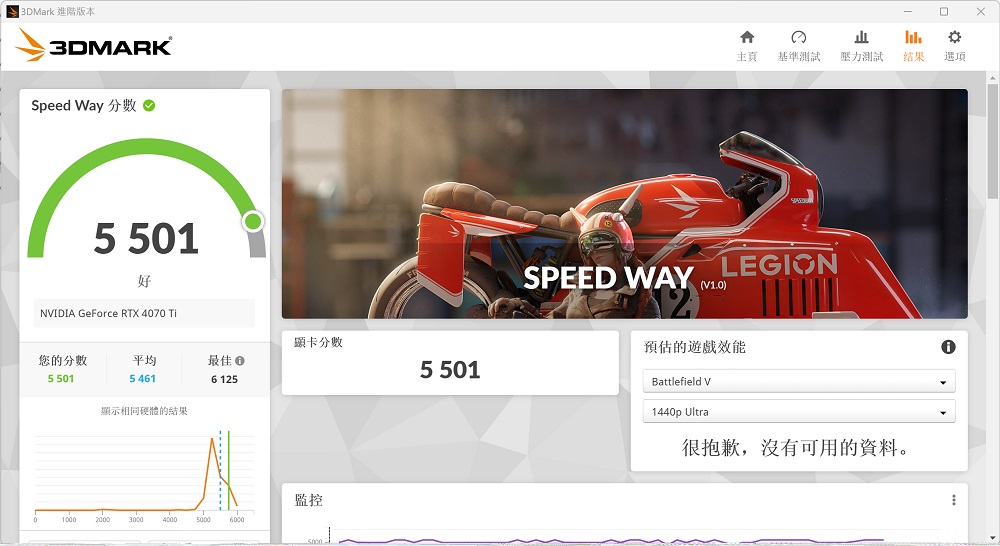
3DMark DLSS Function Test Overview:
3DMark offers a DLSS (Deep Learning Super Sampling) feature test that allows users to measure the performance gains achieved through Nvidia’s DLSS technology. DLSS employs AI and machine learning to produce images that look like a higher resolution without the heavy computational load. Different versions of DLSS (DLSS 1, DLSS 2, and DLSS 3) can be tested, but it’s worth noting that only the latest NVIDIA RTX 40 series cards support DLSS 3.
You have the flexibility to test across multiple resolutions: 1080p, 1440p, 4K, and even 8K. Additionally, for each resolution, you can choose between Quality and Performance modes, which control the balance between image quality and frame rate. For 8K resolution, there’s an Ultra Performance mode, designed to maximize frame rates.
Test Methodology:
The test follows the same procedure as the Port Royal benchmark and is run twice to get reliable results. The author chose to use Performance mode for 2K and 4K resolutions and Ultra Performance mode for 8K resolution tests.
- DLSS Modes:
- 1080p, 1440p, 4K: Quality and Performance
- 8K: Ultra Performance
By providing frame rate (FPS) charts for enabling and disabling DLSS across different resolutions and DLSS versions, users can get a clear idea of the performance improvements that DLSS offers. This is particularly useful for those looking to maximize performance without significantly sacrificing image quality.
This test, coupled with other benchmark scores, can offer a comprehensive understanding of how well a graphics card like the GALAX GeForce RTX 4070 Ti EX Gamer 1-Click OC performs across a variety of gaming and computational scenarios. It also adds context to the card’s ability to handle future games and applications that will leverage these advanced DLSS features.
Three FPS E-sports Games Test
For practical evaluation, three seminal FPS e-sports games were chosen: “Overwatch 2,” “Tom Clancy’s Rainbow Six Siege,” and “Apex Legends.”
In this trio of first-person shooter e-sports titles, only “Tom Clancy’s Rainbow Six Siege” comes with an integrated performance assessment tool. For the other two games, frame data is gathered within the shooting practice area. It’s worth noting that Apex Legends caps the frame rate at 144 by default. To exceed this limit, you’d need to manually input specific code. Consequently, the author will conduct the frame rate test for Apex Legends based on this default setting.
The test of nine AAA masterpiece games
To focus on evaluating screen performance and narrative experience in AAA titles, the author selected nine standout games for testing: “Hogwarts Legacy,” “The Witcher 3: Wild Hunt,” “Cyberpunk 2077,” “Watch Dogs: Legion,” “Far Cry 6,” “God of War,” “Red Dead Redemption 2,” “Horizon Zero Dawn,” and “Assassin’s Creed Valhalla.”
Given that most players prioritize visual fidelity over peak frame rates when playing AAA games, the author configured the games to use the “highest” available texture and special effects settings. Additionally, NVIDIA’s DLSS technology, supported by most of these nine titles, was set to “Quality/Image Quality” to strike a balance between frame rate and visual appeal. Frame rate data was captured using software to record average (AVG) and 1% Low FPS values.
Using the GALAX GeForce RTX 4070 Ti EX Gamer 1-Click OC graphics card at a 1440p resolution, the test yielded an average score exceeding 136 fps. Across the nine AAA titles, the total average score was 168 fps, while the 1% Low FPS had a total average score of 127.3 fps. Even at the more demanding 2160p resolution, the average frame rate remained above 77 fps.
Five ray tracing games tested
The NVIDIA RTX 40 series graphics cards come equipped with a third-generation RT Core, delivering enhanced ray tracing capabilities compared to the preceding RTX 30 series. For the purposes of testing ray tracing DXR (DirectX Raytracing) performance, five games were selected: “Hogwarts Legacy,” “The Witcher 3: Wild Hunt,” “Cyberpunk 2077,” “Watch Dogs: Legion,” and “Far Cry 6.” For these tests, both the special effects and ray tracing settings were maxed out to the “Highest” option, with DLSS set to quality mode and AMD FSR also in quality mode.
In these real-time ray tracing tests, the GALAX GeForce RTX 4070 Ti EX Gamer 1-Click OC graphics card effortlessly achieved an average of 100 fps at 1440p resolution. Even at the more demanding 2160p resolution, the card managed to surpass the 60 fps threshold in the two most performance-intensive games, ensuring smooth gameplay.
Display card temperature and power consumption test
The graphics card was tested on an open-air platform in a room with an ambient temperature of 27°C to evaluate its temperature and power consumption. For this purpose, the author utilized “Cyberpunk 2077,” Time Spy, and Furmark as the benchmarking tools. Data was gathered using the HWiNFO64 software to record peak GPU temperature and graphics memory junction temperature, as well as GPU power consumption. It’s worth noting that software-monitored data may have a 1-3% margin of error, so the results should be taken as a reference point rather than as absolute values.
Summarize
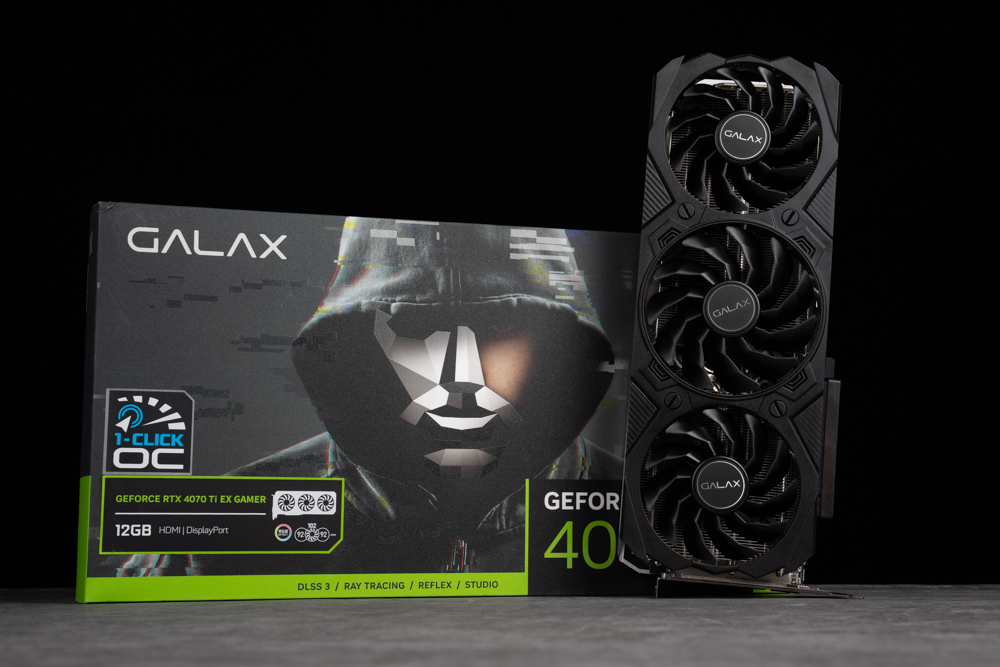
The GALAX GeForce RTX 4070 Ti EX Gamer 1-Click OC graphics card is well-suited for gaming at a 2K 1440p resolution, effortlessly achieving an average frame rate of over 136 fps with ray tracing disabled. When ray tracing is activated, the card leverages DLSS 3 technology and its third-generation RT Core to maintain an impressive average frame rate of around 100 fps. Even when tackling 4K 2160p games that demand higher performance for ray tracing, it still manages a commendable average score of 79.4 fps.
Although its design is more understated compared to its V2 counterpart, the GALAX GeForce RTX 4070 Ti EX Gamer 1-Click OC offers robust performance. Novice users will appreciate the 1-Click OC feature in the Xtreme Tuner Plus software for easy overclocking. With a peak operating temperature of 72.3°C, the card stays relatively cool. If you’re aiming for smooth gameplay at either 2K or 4K resolutions, this graphics card proves to be more than capable.
If this article is helpful for you, please share this article with your friends on social media. Thank you!
This article is based on the personality of the reviews. You are responsible for fact-checking if the contents are not facts or accurate.
Title: Easily surpasses 4K performance benchmarks! Unveiling and testing the GALAX GeForce RTX 4070 Ti EX Gamer Graphics Card with One-Click Overclocking